Management Accounting Report: ABC Company's Financial Strategies
VerifiedAdded on 2023/01/10
|24
|3992
|21
Report
AI Summary
This report delves into management accounting practices, focusing on ABC Company's financial strategies. It examines cost classifications, including marginal and opportunity costs, and applies absorption and marginal costing methods to calculate unit costs for Personal Computers (PC) and Video Players (VP). The report analyzes the impact of limited direct labor hours on production mix, advising on profit maximization. Furthermore, it explores the budgeting process, its functions, and the advantages and disadvantages of budgetary control systems. The report also includes the preparation of various budgets and raw material variance calculations. It concludes with recommendations based on the findings, emphasizing the importance of marginal costing for special orders and break-even analysis.
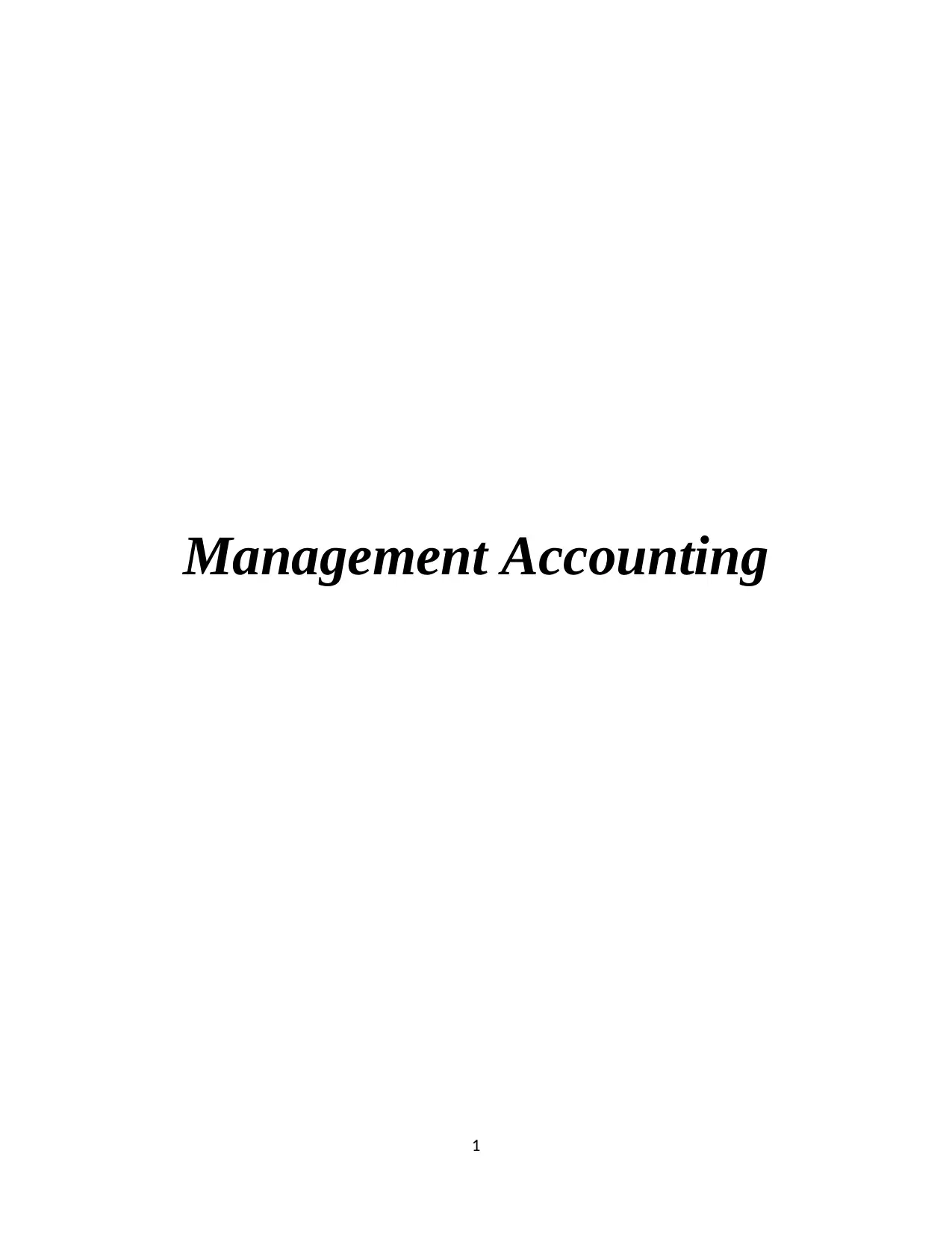
Management Accounting
1
1
Secure Best Marks with AI Grader
Need help grading? Try our AI Grader for instant feedback on your assignments.
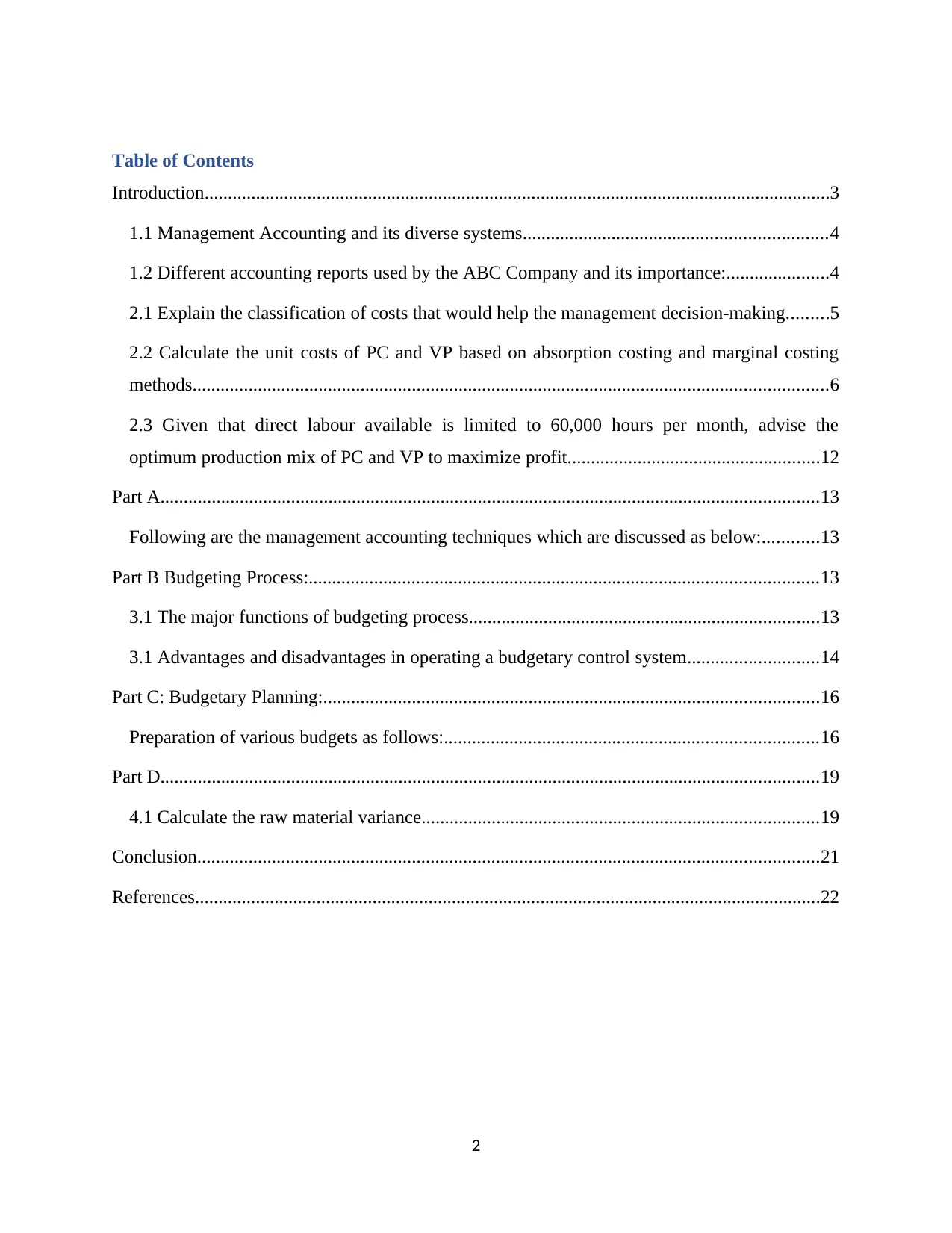
Table of Contents
Introduction......................................................................................................................................3
1.1 Management Accounting and its diverse systems.................................................................4
1.2 Different accounting reports used by the ABC Company and its importance:......................4
2.1 Explain the classification of costs that would help the management decision-making.........5
2.2 Calculate the unit costs of PC and VP based on absorption costing and marginal costing
methods........................................................................................................................................6
2.3 Given that direct labour available is limited to 60,000 hours per month, advise the
optimum production mix of PC and VP to maximize profit......................................................12
Part A.............................................................................................................................................13
Following are the management accounting techniques which are discussed as below:............13
Part B Budgeting Process:.............................................................................................................13
3.1 The major functions of budgeting process...........................................................................13
3.1 Advantages and disadvantages in operating a budgetary control system............................14
Part C: Budgetary Planning:..........................................................................................................16
Preparation of various budgets as follows:................................................................................16
Part D.............................................................................................................................................19
4.1 Calculate the raw material variance.....................................................................................19
Conclusion.....................................................................................................................................21
References......................................................................................................................................22
2
Introduction......................................................................................................................................3
1.1 Management Accounting and its diverse systems.................................................................4
1.2 Different accounting reports used by the ABC Company and its importance:......................4
2.1 Explain the classification of costs that would help the management decision-making.........5
2.2 Calculate the unit costs of PC and VP based on absorption costing and marginal costing
methods........................................................................................................................................6
2.3 Given that direct labour available is limited to 60,000 hours per month, advise the
optimum production mix of PC and VP to maximize profit......................................................12
Part A.............................................................................................................................................13
Following are the management accounting techniques which are discussed as below:............13
Part B Budgeting Process:.............................................................................................................13
3.1 The major functions of budgeting process...........................................................................13
3.1 Advantages and disadvantages in operating a budgetary control system............................14
Part C: Budgetary Planning:..........................................................................................................16
Preparation of various budgets as follows:................................................................................16
Part D.............................................................................................................................................19
4.1 Calculate the raw material variance.....................................................................................19
Conclusion.....................................................................................................................................21
References......................................................................................................................................22
2
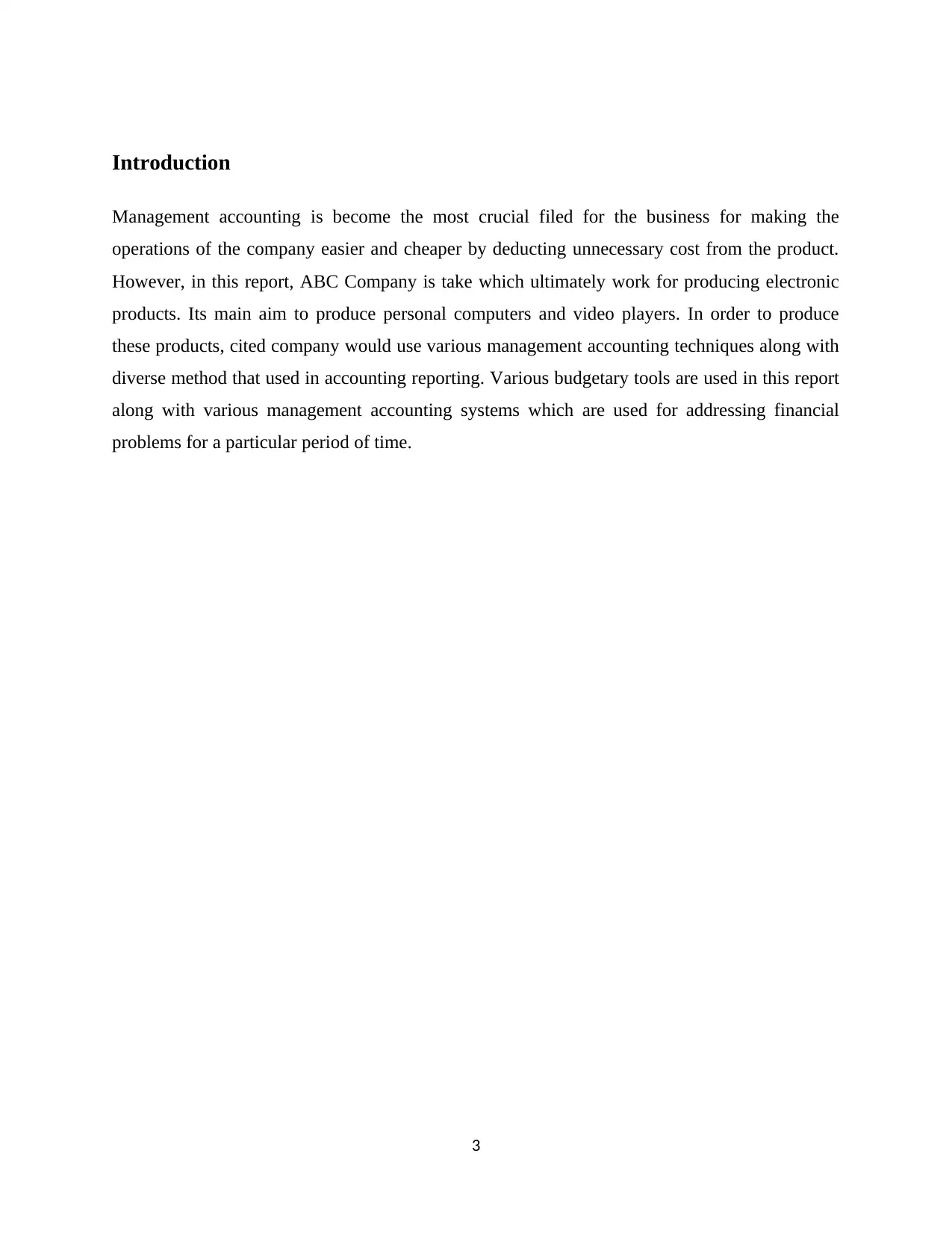
Introduction
Management accounting is become the most crucial filed for the business for making the
operations of the company easier and cheaper by deducting unnecessary cost from the product.
However, in this report, ABC Company is take which ultimately work for producing electronic
products. Its main aim to produce personal computers and video players. In order to produce
these products, cited company would use various management accounting techniques along with
diverse method that used in accounting reporting. Various budgetary tools are used in this report
along with various management accounting systems which are used for addressing financial
problems for a particular period of time.
3
Management accounting is become the most crucial filed for the business for making the
operations of the company easier and cheaper by deducting unnecessary cost from the product.
However, in this report, ABC Company is take which ultimately work for producing electronic
products. Its main aim to produce personal computers and video players. In order to produce
these products, cited company would use various management accounting techniques along with
diverse method that used in accounting reporting. Various budgetary tools are used in this report
along with various management accounting systems which are used for addressing financial
problems for a particular period of time.
3
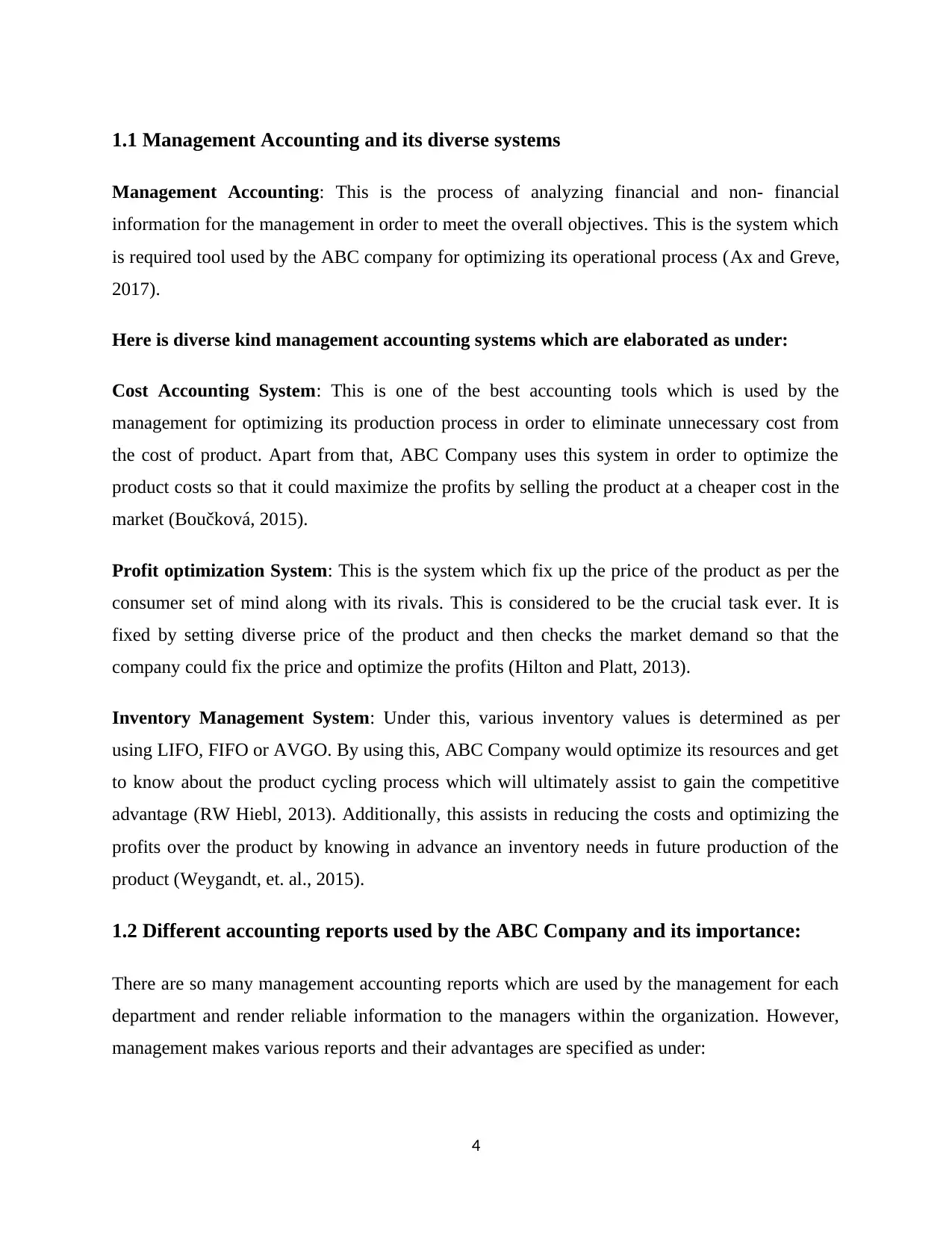
1.1 Management Accounting and its diverse systems
Management Accounting: This is the process of analyzing financial and non- financial
information for the management in order to meet the overall objectives. This is the system which
is required tool used by the ABC company for optimizing its operational process (Ax and Greve,
2017).
Here is diverse kind management accounting systems which are elaborated as under:
Cost Accounting System: This is one of the best accounting tools which is used by the
management for optimizing its production process in order to eliminate unnecessary cost from
the cost of product. Apart from that, ABC Company uses this system in order to optimize the
product costs so that it could maximize the profits by selling the product at a cheaper cost in the
market (Boučková, 2015).
Profit optimization System: This is the system which fix up the price of the product as per the
consumer set of mind along with its rivals. This is considered to be the crucial task ever. It is
fixed by setting diverse price of the product and then checks the market demand so that the
company could fix the price and optimize the profits (Hilton and Platt, 2013).
Inventory Management System: Under this, various inventory values is determined as per
using LIFO, FIFO or AVGO. By using this, ABC Company would optimize its resources and get
to know about the product cycling process which will ultimately assist to gain the competitive
advantage (RW Hiebl, 2013). Additionally, this assists in reducing the costs and optimizing the
profits over the product by knowing in advance an inventory needs in future production of the
product (Weygandt, et. al., 2015).
1.2 Different accounting reports used by the ABC Company and its importance:
There are so many management accounting reports which are used by the management for each
department and render reliable information to the managers within the organization. However,
management makes various reports and their advantages are specified as under:
4
Management Accounting: This is the process of analyzing financial and non- financial
information for the management in order to meet the overall objectives. This is the system which
is required tool used by the ABC company for optimizing its operational process (Ax and Greve,
2017).
Here is diverse kind management accounting systems which are elaborated as under:
Cost Accounting System: This is one of the best accounting tools which is used by the
management for optimizing its production process in order to eliminate unnecessary cost from
the cost of product. Apart from that, ABC Company uses this system in order to optimize the
product costs so that it could maximize the profits by selling the product at a cheaper cost in the
market (Boučková, 2015).
Profit optimization System: This is the system which fix up the price of the product as per the
consumer set of mind along with its rivals. This is considered to be the crucial task ever. It is
fixed by setting diverse price of the product and then checks the market demand so that the
company could fix the price and optimize the profits (Hilton and Platt, 2013).
Inventory Management System: Under this, various inventory values is determined as per
using LIFO, FIFO or AVGO. By using this, ABC Company would optimize its resources and get
to know about the product cycling process which will ultimately assist to gain the competitive
advantage (RW Hiebl, 2013). Additionally, this assists in reducing the costs and optimizing the
profits over the product by knowing in advance an inventory needs in future production of the
product (Weygandt, et. al., 2015).
1.2 Different accounting reports used by the ABC Company and its importance:
There are so many management accounting reports which are used by the management for each
department and render reliable information to the managers within the organization. However,
management makes various reports and their advantages are specified as under:
4
Secure Best Marks with AI Grader
Need help grading? Try our AI Grader for instant feedback on your assignments.
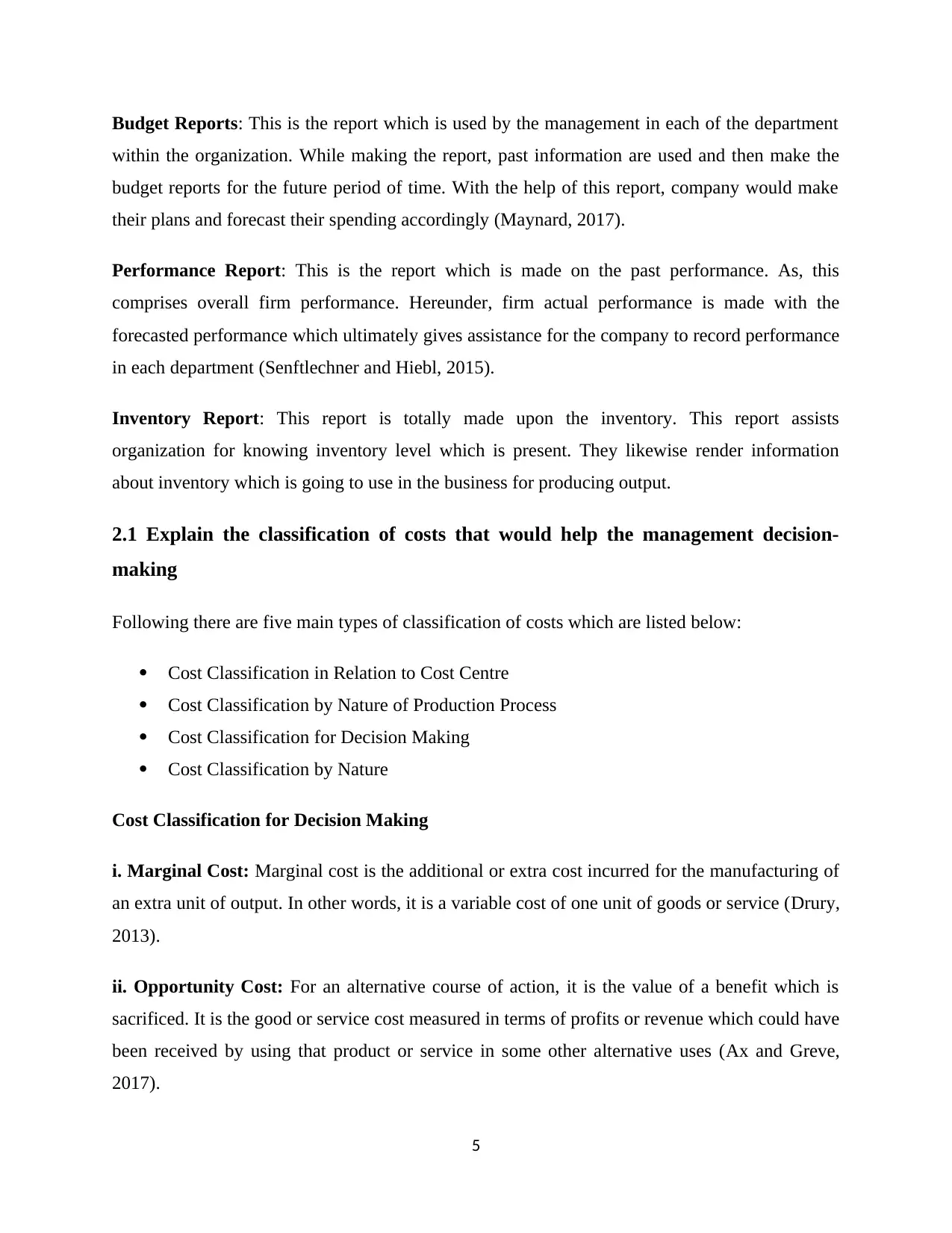
Budget Reports: This is the report which is used by the management in each of the department
within the organization. While making the report, past information are used and then make the
budget reports for the future period of time. With the help of this report, company would make
their plans and forecast their spending accordingly (Maynard, 2017).
Performance Report: This is the report which is made on the past performance. As, this
comprises overall firm performance. Hereunder, firm actual performance is made with the
forecasted performance which ultimately gives assistance for the company to record performance
in each department (Senftlechner and Hiebl, 2015).
Inventory Report: This report is totally made upon the inventory. This report assists
organization for knowing inventory level which is present. They likewise render information
about inventory which is going to use in the business for producing output.
2.1 Explain the classification of costs that would help the management decision-
making
Following there are five main types of classification of costs which are listed below:
Cost Classification in Relation to Cost Centre
Cost Classification by Nature of Production Process
Cost Classification for Decision Making
Cost Classification by Nature
Cost Classification for Decision Making
i. Marginal Cost: Marginal cost is the additional or extra cost incurred for the manufacturing of
an extra unit of output. In other words, it is a variable cost of one unit of goods or service (Drury,
2013).
ii. Opportunity Cost: For an alternative course of action, it is the value of a benefit which is
sacrificed. It is the good or service cost measured in terms of profits or revenue which could have
been received by using that product or service in some other alternative uses (Ax and Greve,
2017).
5
within the organization. While making the report, past information are used and then make the
budget reports for the future period of time. With the help of this report, company would make
their plans and forecast their spending accordingly (Maynard, 2017).
Performance Report: This is the report which is made on the past performance. As, this
comprises overall firm performance. Hereunder, firm actual performance is made with the
forecasted performance which ultimately gives assistance for the company to record performance
in each department (Senftlechner and Hiebl, 2015).
Inventory Report: This report is totally made upon the inventory. This report assists
organization for knowing inventory level which is present. They likewise render information
about inventory which is going to use in the business for producing output.
2.1 Explain the classification of costs that would help the management decision-
making
Following there are five main types of classification of costs which are listed below:
Cost Classification in Relation to Cost Centre
Cost Classification by Nature of Production Process
Cost Classification for Decision Making
Cost Classification by Nature
Cost Classification for Decision Making
i. Marginal Cost: Marginal cost is the additional or extra cost incurred for the manufacturing of
an extra unit of output. In other words, it is a variable cost of one unit of goods or service (Drury,
2013).
ii. Opportunity Cost: For an alternative course of action, it is the value of a benefit which is
sacrificed. It is the good or service cost measured in terms of profits or revenue which could have
been received by using that product or service in some other alternative uses (Ax and Greve,
2017).
5
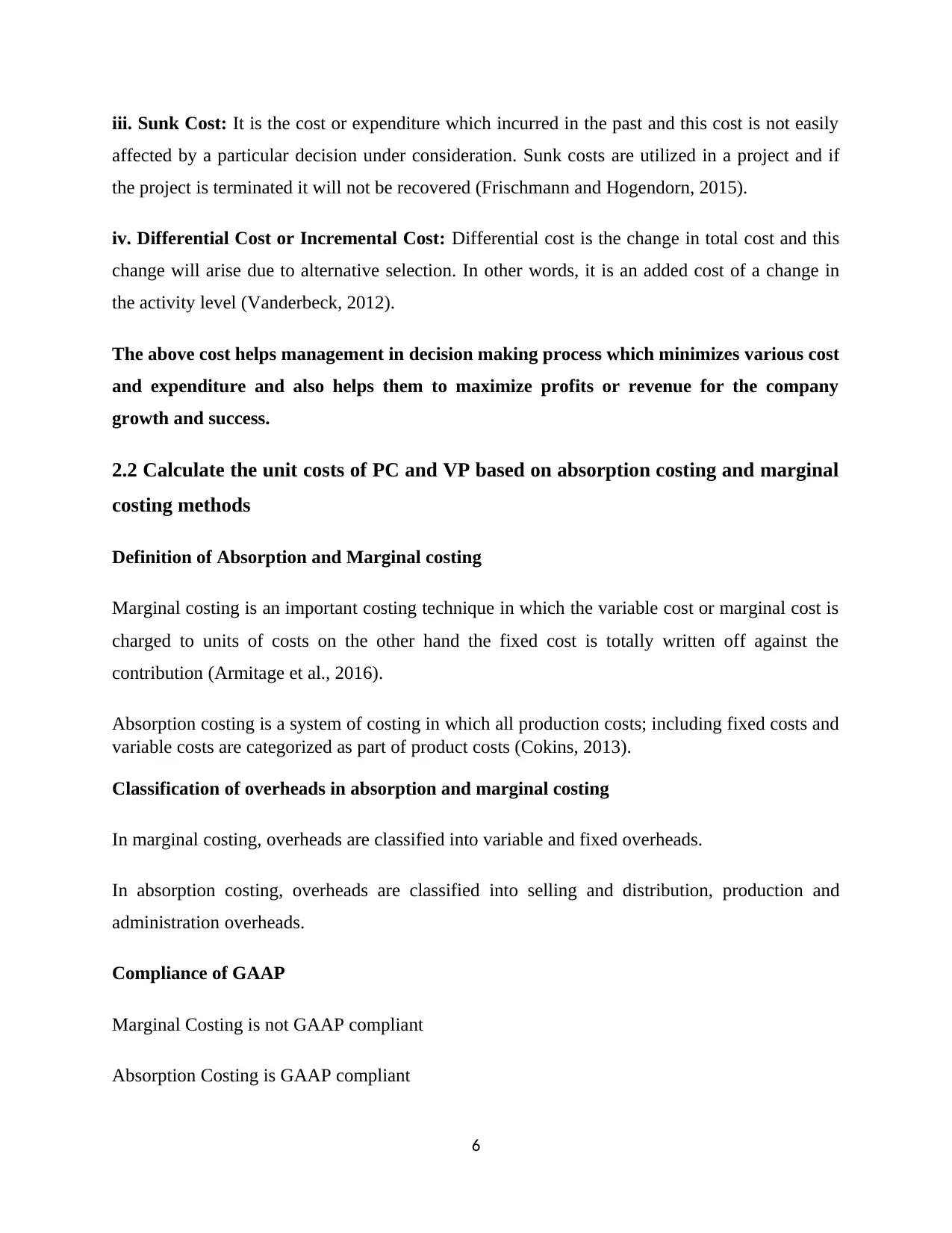
iii. Sunk Cost: It is the cost or expenditure which incurred in the past and this cost is not easily
affected by a particular decision under consideration. Sunk costs are utilized in a project and if
the project is terminated it will not be recovered (Frischmann and Hogendorn, 2015).
iv. Differential Cost or Incremental Cost: Differential cost is the change in total cost and this
change will arise due to alternative selection. In other words, it is an added cost of a change in
the activity level (Vanderbeck, 2012).
The above cost helps management in decision making process which minimizes various cost
and expenditure and also helps them to maximize profits or revenue for the company
growth and success.
2.2 Calculate the unit costs of PC and VP based on absorption costing and marginal
costing methods
Definition of Absorption and Marginal costing
Marginal costing is an important costing technique in which the variable cost or marginal cost is
charged to units of costs on the other hand the fixed cost is totally written off against the
contribution (Armitage et al., 2016).
Absorption costing is a system of costing in which all production costs; including fixed costs and
variable costs are categorized as part of product costs (Cokins, 2013).
Classification of overheads in absorption and marginal costing
In marginal costing, overheads are classified into variable and fixed overheads.
In absorption costing, overheads are classified into selling and distribution, production and
administration overheads.
Compliance of GAAP
Marginal Costing is not GAAP compliant
Absorption Costing is GAAP compliant
6
affected by a particular decision under consideration. Sunk costs are utilized in a project and if
the project is terminated it will not be recovered (Frischmann and Hogendorn, 2015).
iv. Differential Cost or Incremental Cost: Differential cost is the change in total cost and this
change will arise due to alternative selection. In other words, it is an added cost of a change in
the activity level (Vanderbeck, 2012).
The above cost helps management in decision making process which minimizes various cost
and expenditure and also helps them to maximize profits or revenue for the company
growth and success.
2.2 Calculate the unit costs of PC and VP based on absorption costing and marginal
costing methods
Definition of Absorption and Marginal costing
Marginal costing is an important costing technique in which the variable cost or marginal cost is
charged to units of costs on the other hand the fixed cost is totally written off against the
contribution (Armitage et al., 2016).
Absorption costing is a system of costing in which all production costs; including fixed costs and
variable costs are categorized as part of product costs (Cokins, 2013).
Classification of overheads in absorption and marginal costing
In marginal costing, overheads are classified into variable and fixed overheads.
In absorption costing, overheads are classified into selling and distribution, production and
administration overheads.
Compliance of GAAP
Marginal Costing is not GAAP compliant
Absorption Costing is GAAP compliant
6
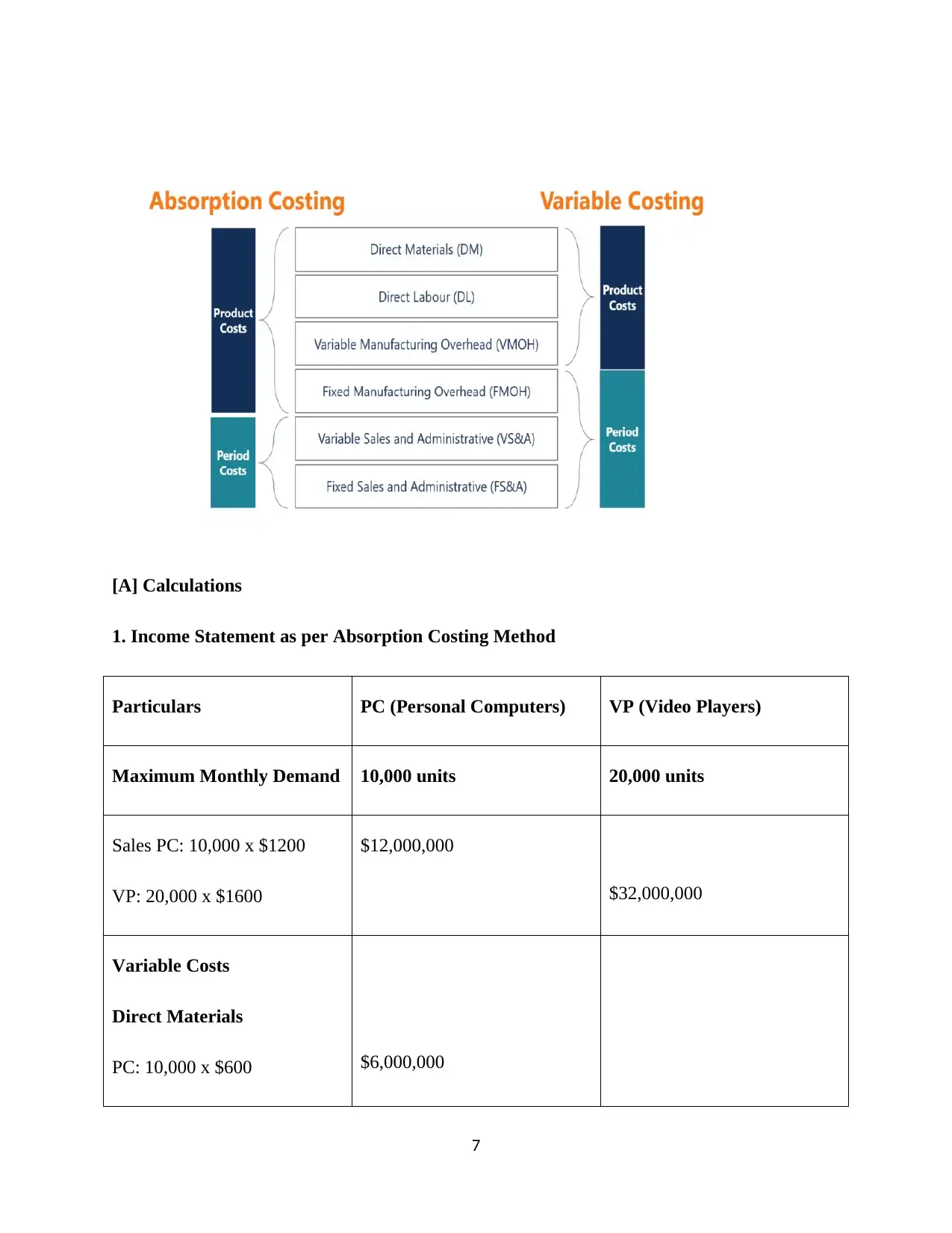
[A] Calculations
1. Income Statement as per Absorption Costing Method
Particulars PC (Personal Computers) VP (Video Players)
Maximum Monthly Demand 10,000 units 20,000 units
Sales PC: 10,000 x $1200
VP: 20,000 x $1600
$12,000,000
$32,000,000
Variable Costs
Direct Materials
PC: 10,000 x $600 $6,000,000
7
1. Income Statement as per Absorption Costing Method
Particulars PC (Personal Computers) VP (Video Players)
Maximum Monthly Demand 10,000 units 20,000 units
Sales PC: 10,000 x $1200
VP: 20,000 x $1600
$12,000,000
$32,000,000
Variable Costs
Direct Materials
PC: 10,000 x $600 $6,000,000
7
Paraphrase This Document
Need a fresh take? Get an instant paraphrase of this document with our AI Paraphraser
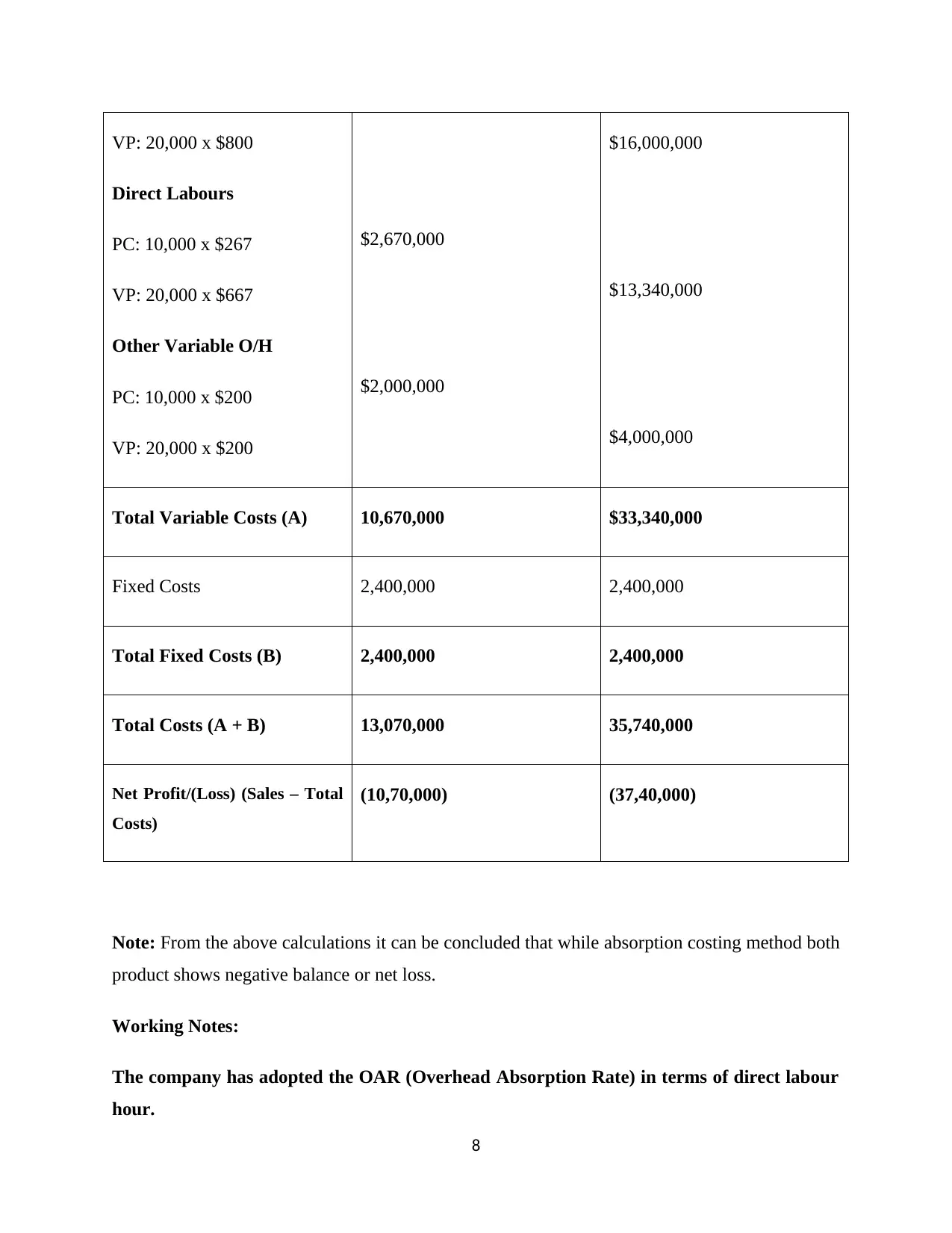
VP: 20,000 x $800
Direct Labours
PC: 10,000 x $267
VP: 20,000 x $667
Other Variable O/H
PC: 10,000 x $200
VP: 20,000 x $200
$2,670,000
$2,000,000
$16,000,000
$13,340,000
$4,000,000
Total Variable Costs (A) 10,670,000 $33,340,000
Fixed Costs 2,400,000 2,400,000
Total Fixed Costs (B) 2,400,000 2,400,000
Total Costs (A + B) 13,070,000 35,740,000
Net Profit/(Loss) (Sales – Total
Costs)
(10,70,000) (37,40,000)
Note: From the above calculations it can be concluded that while absorption costing method both
product shows negative balance or net loss.
Working Notes:
The company has adopted the OAR (Overhead Absorption Rate) in terms of direct labour
hour.
8
Direct Labours
PC: 10,000 x $267
VP: 20,000 x $667
Other Variable O/H
PC: 10,000 x $200
VP: 20,000 x $200
$2,670,000
$2,000,000
$16,000,000
$13,340,000
$4,000,000
Total Variable Costs (A) 10,670,000 $33,340,000
Fixed Costs 2,400,000 2,400,000
Total Fixed Costs (B) 2,400,000 2,400,000
Total Costs (A + B) 13,070,000 35,740,000
Net Profit/(Loss) (Sales – Total
Costs)
(10,70,000) (37,40,000)
Note: From the above calculations it can be concluded that while absorption costing method both
product shows negative balance or net loss.
Working Notes:
The company has adopted the OAR (Overhead Absorption Rate) in terms of direct labour
hour.
8
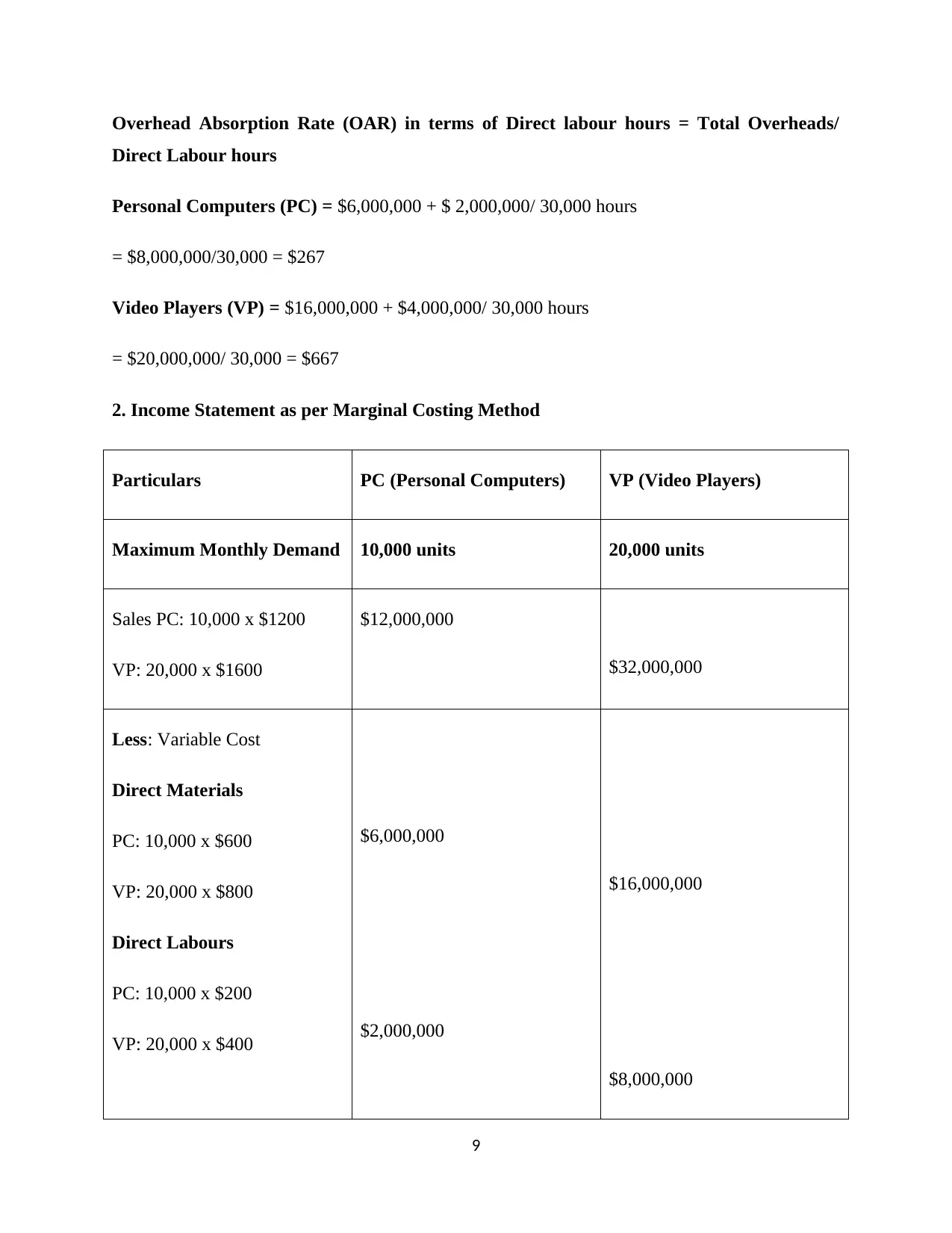
Overhead Absorption Rate (OAR) in terms of Direct labour hours = Total Overheads/
Direct Labour hours
Personal Computers (PC) = $6,000,000 + $ 2,000,000/ 30,000 hours
= $8,000,000/30,000 = $267
Video Players (VP) = $16,000,000 + $4,000,000/ 30,000 hours
= $20,000,000/ 30,000 = $667
2. Income Statement as per Marginal Costing Method
Particulars PC (Personal Computers) VP (Video Players)
Maximum Monthly Demand 10,000 units 20,000 units
Sales PC: 10,000 x $1200
VP: 20,000 x $1600
$12,000,000
$32,000,000
Less: Variable Cost
Direct Materials
PC: 10,000 x $600
VP: 20,000 x $800
Direct Labours
PC: 10,000 x $200
VP: 20,000 x $400
$6,000,000
$2,000,000
$16,000,000
$8,000,000
9
Direct Labour hours
Personal Computers (PC) = $6,000,000 + $ 2,000,000/ 30,000 hours
= $8,000,000/30,000 = $267
Video Players (VP) = $16,000,000 + $4,000,000/ 30,000 hours
= $20,000,000/ 30,000 = $667
2. Income Statement as per Marginal Costing Method
Particulars PC (Personal Computers) VP (Video Players)
Maximum Monthly Demand 10,000 units 20,000 units
Sales PC: 10,000 x $1200
VP: 20,000 x $1600
$12,000,000
$32,000,000
Less: Variable Cost
Direct Materials
PC: 10,000 x $600
VP: 20,000 x $800
Direct Labours
PC: 10,000 x $200
VP: 20,000 x $400
$6,000,000
$2,000,000
$16,000,000
$8,000,000
9
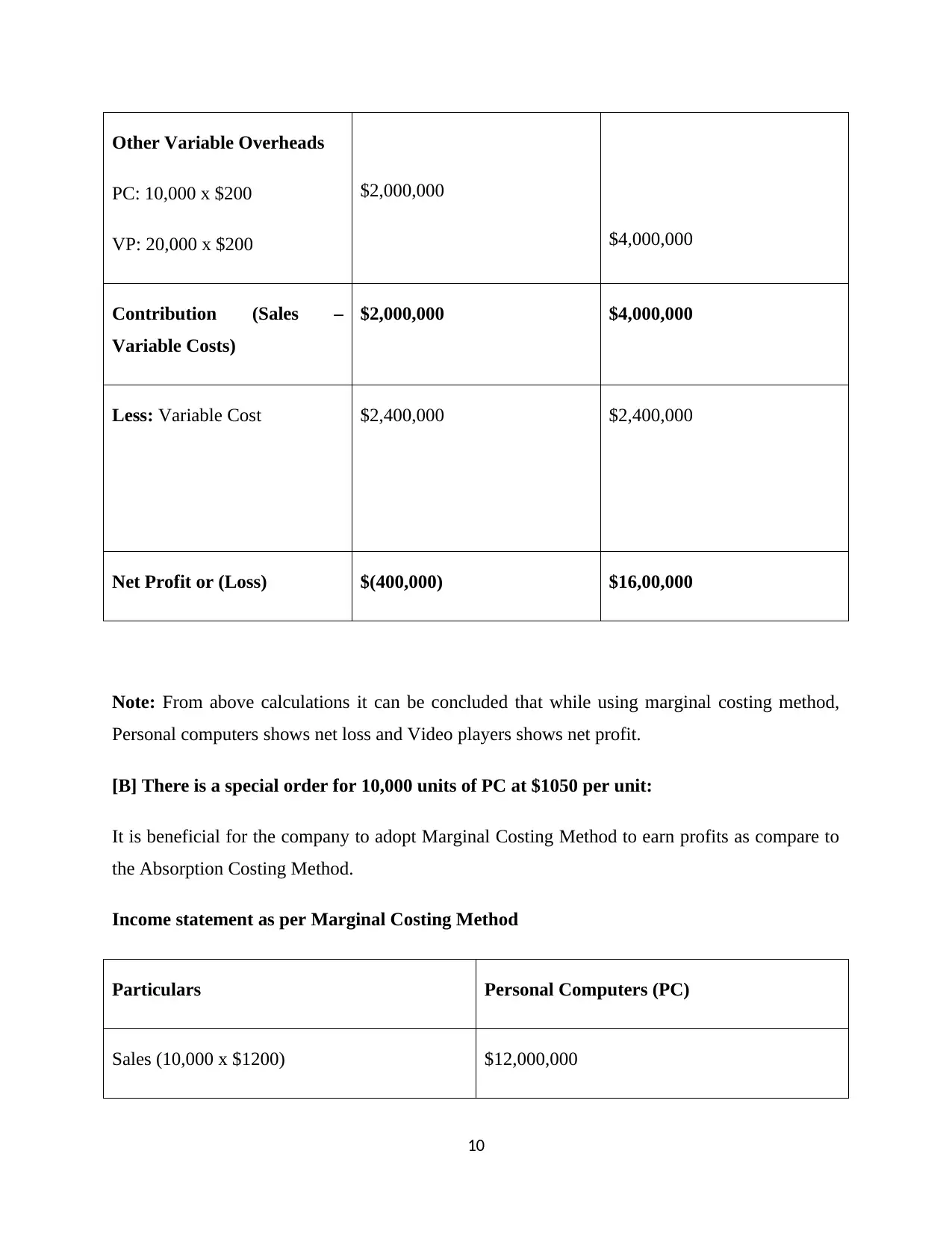
Other Variable Overheads
PC: 10,000 x $200
VP: 20,000 x $200
$2,000,000
$4,000,000
Contribution (Sales –
Variable Costs)
$2,000,000 $4,000,000
Less: Variable Cost $2,400,000 $2,400,000
Net Profit or (Loss) $(400,000) $16,00,000
Note: From above calculations it can be concluded that while using marginal costing method,
Personal computers shows net loss and Video players shows net profit.
[B] There is a special order for 10,000 units of PC at $1050 per unit:
It is beneficial for the company to adopt Marginal Costing Method to earn profits as compare to
the Absorption Costing Method.
Income statement as per Marginal Costing Method
Particulars Personal Computers (PC)
Sales (10,000 x $1200) $12,000,000
10
PC: 10,000 x $200
VP: 20,000 x $200
$2,000,000
$4,000,000
Contribution (Sales –
Variable Costs)
$2,000,000 $4,000,000
Less: Variable Cost $2,400,000 $2,400,000
Net Profit or (Loss) $(400,000) $16,00,000
Note: From above calculations it can be concluded that while using marginal costing method,
Personal computers shows net loss and Video players shows net profit.
[B] There is a special order for 10,000 units of PC at $1050 per unit:
It is beneficial for the company to adopt Marginal Costing Method to earn profits as compare to
the Absorption Costing Method.
Income statement as per Marginal Costing Method
Particulars Personal Computers (PC)
Sales (10,000 x $1200) $12,000,000
10
Secure Best Marks with AI Grader
Need help grading? Try our AI Grader for instant feedback on your assignments.
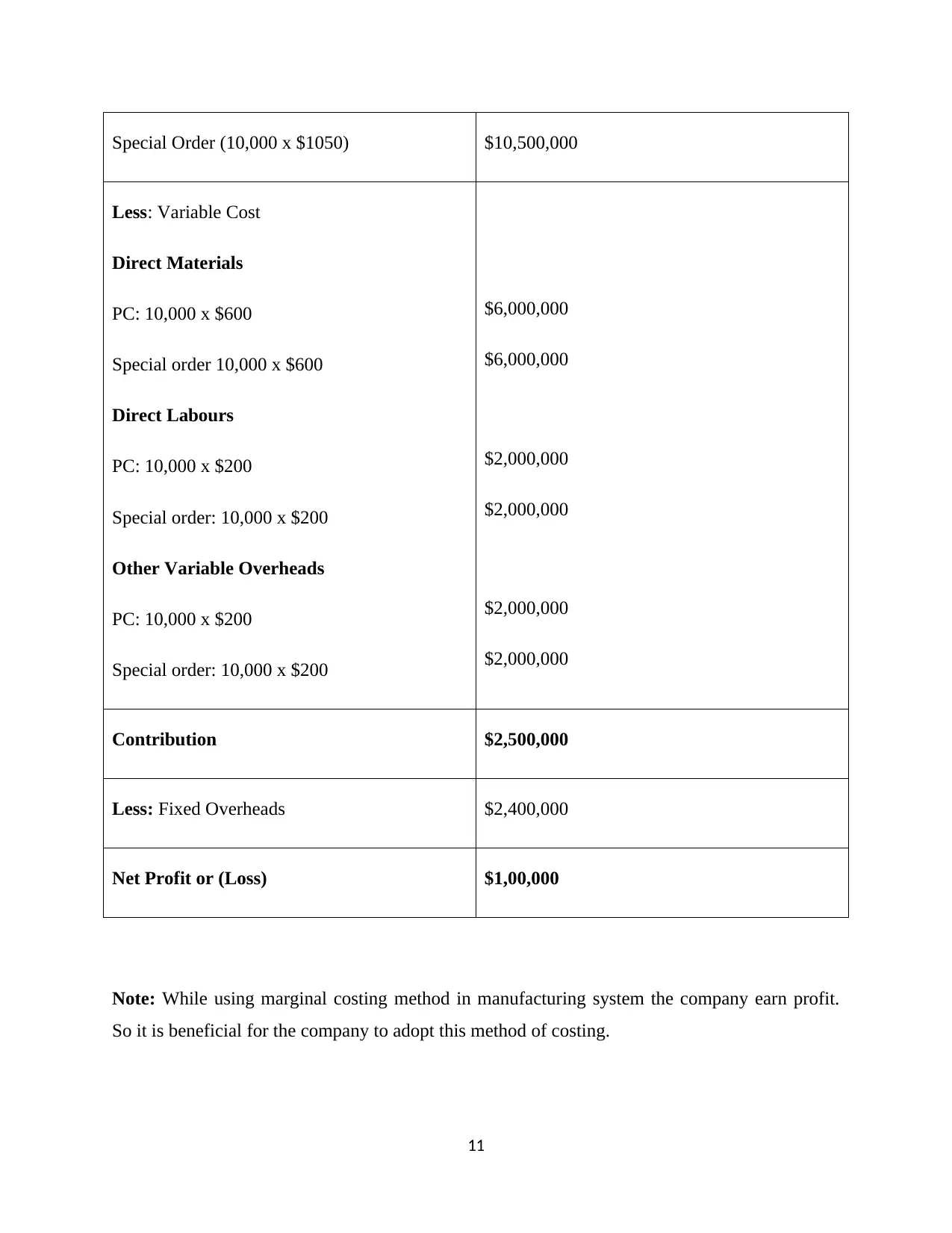
Special Order (10,000 x $1050) $10,500,000
Less: Variable Cost
Direct Materials
PC: 10,000 x $600
Special order 10,000 x $600
Direct Labours
PC: 10,000 x $200
Special order: 10,000 x $200
Other Variable Overheads
PC: 10,000 x $200
Special order: 10,000 x $200
$6,000,000
$6,000,000
$2,000,000
$2,000,000
$2,000,000
$2,000,000
Contribution $2,500,000
Less: Fixed Overheads $2,400,000
Net Profit or (Loss) $1,00,000
Note: While using marginal costing method in manufacturing system the company earn profit.
So it is beneficial for the company to adopt this method of costing.
11
Less: Variable Cost
Direct Materials
PC: 10,000 x $600
Special order 10,000 x $600
Direct Labours
PC: 10,000 x $200
Special order: 10,000 x $200
Other Variable Overheads
PC: 10,000 x $200
Special order: 10,000 x $200
$6,000,000
$6,000,000
$2,000,000
$2,000,000
$2,000,000
$2,000,000
Contribution $2,500,000
Less: Fixed Overheads $2,400,000
Net Profit or (Loss) $1,00,000
Note: While using marginal costing method in manufacturing system the company earn profit.
So it is beneficial for the company to adopt this method of costing.
11
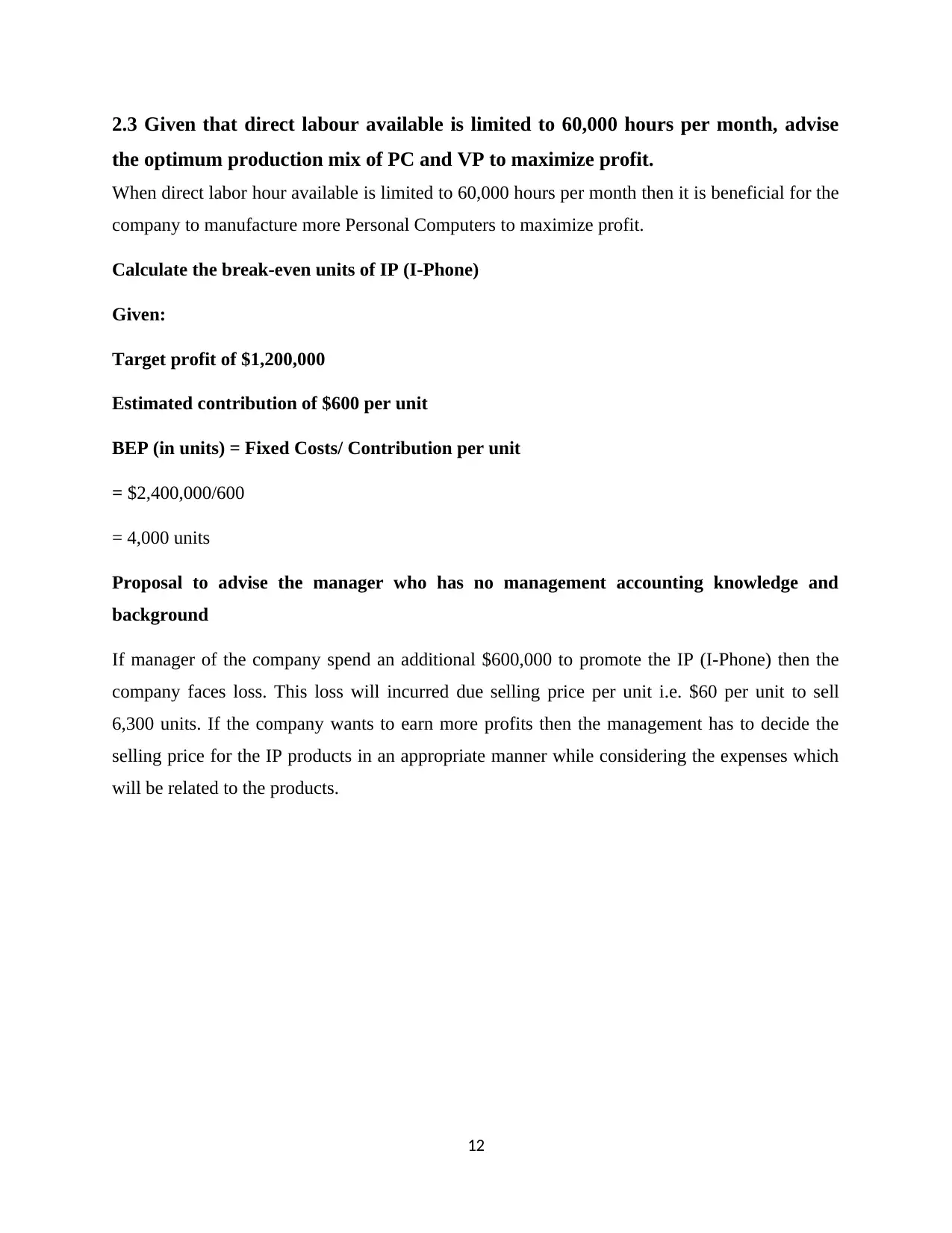
2.3 Given that direct labour available is limited to 60,000 hours per month, advise
the optimum production mix of PC and VP to maximize profit.
When direct labor hour available is limited to 60,000 hours per month then it is beneficial for the
company to manufacture more Personal Computers to maximize profit.
Calculate the break-even units of IP (I-Phone)
Given:
Target profit of $1,200,000
Estimated contribution of $600 per unit
BEP (in units) = Fixed Costs/ Contribution per unit
= $2,400,000/600
= 4,000 units
Proposal to advise the manager who has no management accounting knowledge and
background
If manager of the company spend an additional $600,000 to promote the IP (I-Phone) then the
company faces loss. This loss will incurred due selling price per unit i.e. $60 per unit to sell
6,300 units. If the company wants to earn more profits then the management has to decide the
selling price for the IP products in an appropriate manner while considering the expenses which
will be related to the products.
12
the optimum production mix of PC and VP to maximize profit.
When direct labor hour available is limited to 60,000 hours per month then it is beneficial for the
company to manufacture more Personal Computers to maximize profit.
Calculate the break-even units of IP (I-Phone)
Given:
Target profit of $1,200,000
Estimated contribution of $600 per unit
BEP (in units) = Fixed Costs/ Contribution per unit
= $2,400,000/600
= 4,000 units
Proposal to advise the manager who has no management accounting knowledge and
background
If manager of the company spend an additional $600,000 to promote the IP (I-Phone) then the
company faces loss. This loss will incurred due selling price per unit i.e. $60 per unit to sell
6,300 units. If the company wants to earn more profits then the management has to decide the
selling price for the IP products in an appropriate manner while considering the expenses which
will be related to the products.
12
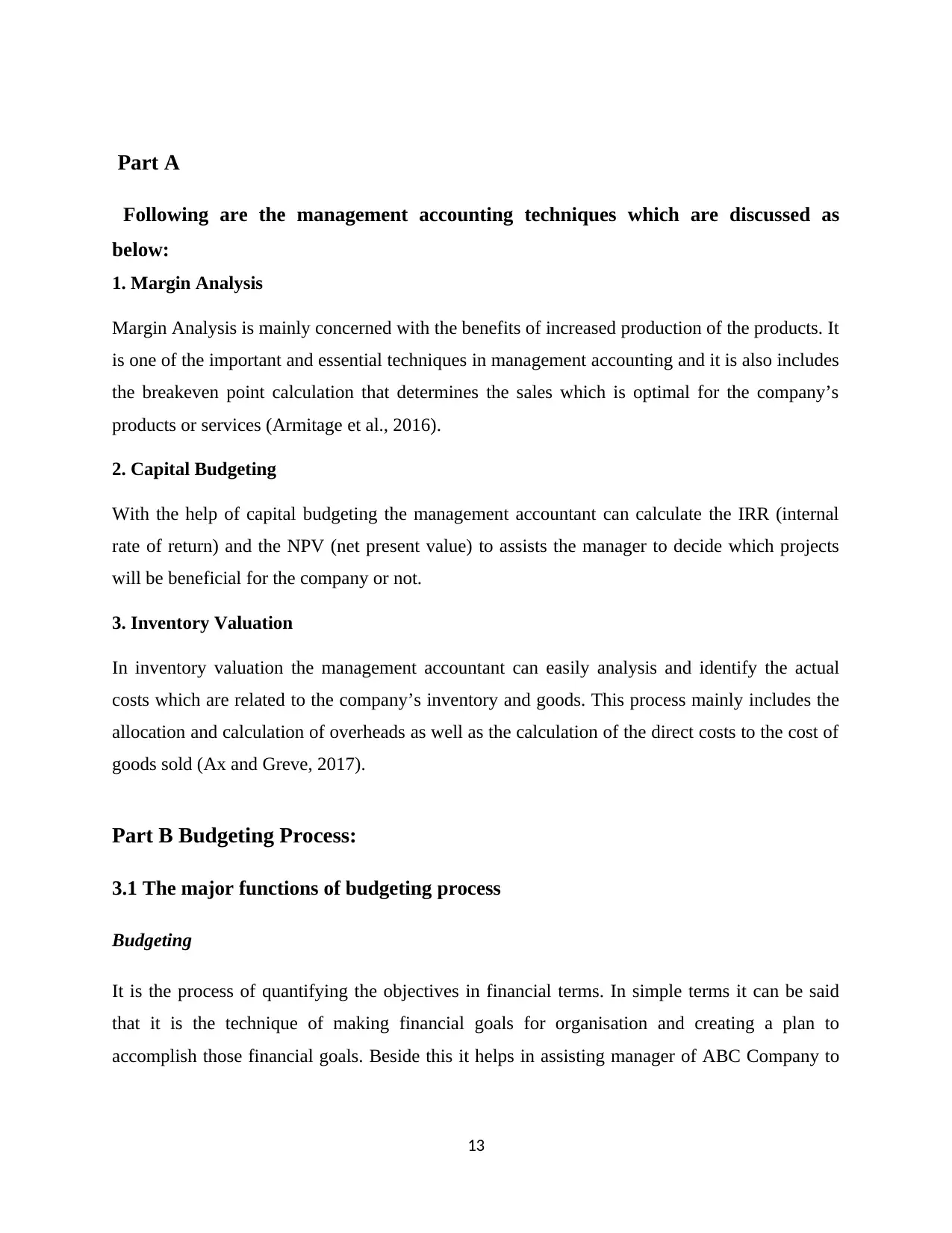
Part A
Following are the management accounting techniques which are discussed as
below:
1. Margin Analysis
Margin Analysis is mainly concerned with the benefits of increased production of the products. It
is one of the important and essential techniques in management accounting and it is also includes
the breakeven point calculation that determines the sales which is optimal for the company’s
products or services (Armitage et al., 2016).
2. Capital Budgeting
With the help of capital budgeting the management accountant can calculate the IRR (internal
rate of return) and the NPV (net present value) to assists the manager to decide which projects
will be beneficial for the company or not.
3. Inventory Valuation
In inventory valuation the management accountant can easily analysis and identify the actual
costs which are related to the company’s inventory and goods. This process mainly includes the
allocation and calculation of overheads as well as the calculation of the direct costs to the cost of
goods sold (Ax and Greve, 2017).
Part B Budgeting Process:
3.1 The major functions of budgeting process
Budgeting
It is the process of quantifying the objectives in financial terms. In simple terms it can be said
that it is the technique of making financial goals for organisation and creating a plan to
accomplish those financial goals. Beside this it helps in assisting manager of ABC Company to
13
Following are the management accounting techniques which are discussed as
below:
1. Margin Analysis
Margin Analysis is mainly concerned with the benefits of increased production of the products. It
is one of the important and essential techniques in management accounting and it is also includes
the breakeven point calculation that determines the sales which is optimal for the company’s
products or services (Armitage et al., 2016).
2. Capital Budgeting
With the help of capital budgeting the management accountant can calculate the IRR (internal
rate of return) and the NPV (net present value) to assists the manager to decide which projects
will be beneficial for the company or not.
3. Inventory Valuation
In inventory valuation the management accountant can easily analysis and identify the actual
costs which are related to the company’s inventory and goods. This process mainly includes the
allocation and calculation of overheads as well as the calculation of the direct costs to the cost of
goods sold (Ax and Greve, 2017).
Part B Budgeting Process:
3.1 The major functions of budgeting process
Budgeting
It is the process of quantifying the objectives in financial terms. In simple terms it can be said
that it is the technique of making financial goals for organisation and creating a plan to
accomplish those financial goals. Beside this it helps in assisting manager of ABC Company to
13
Paraphrase This Document
Need a fresh take? Get an instant paraphrase of this document with our AI Paraphraser
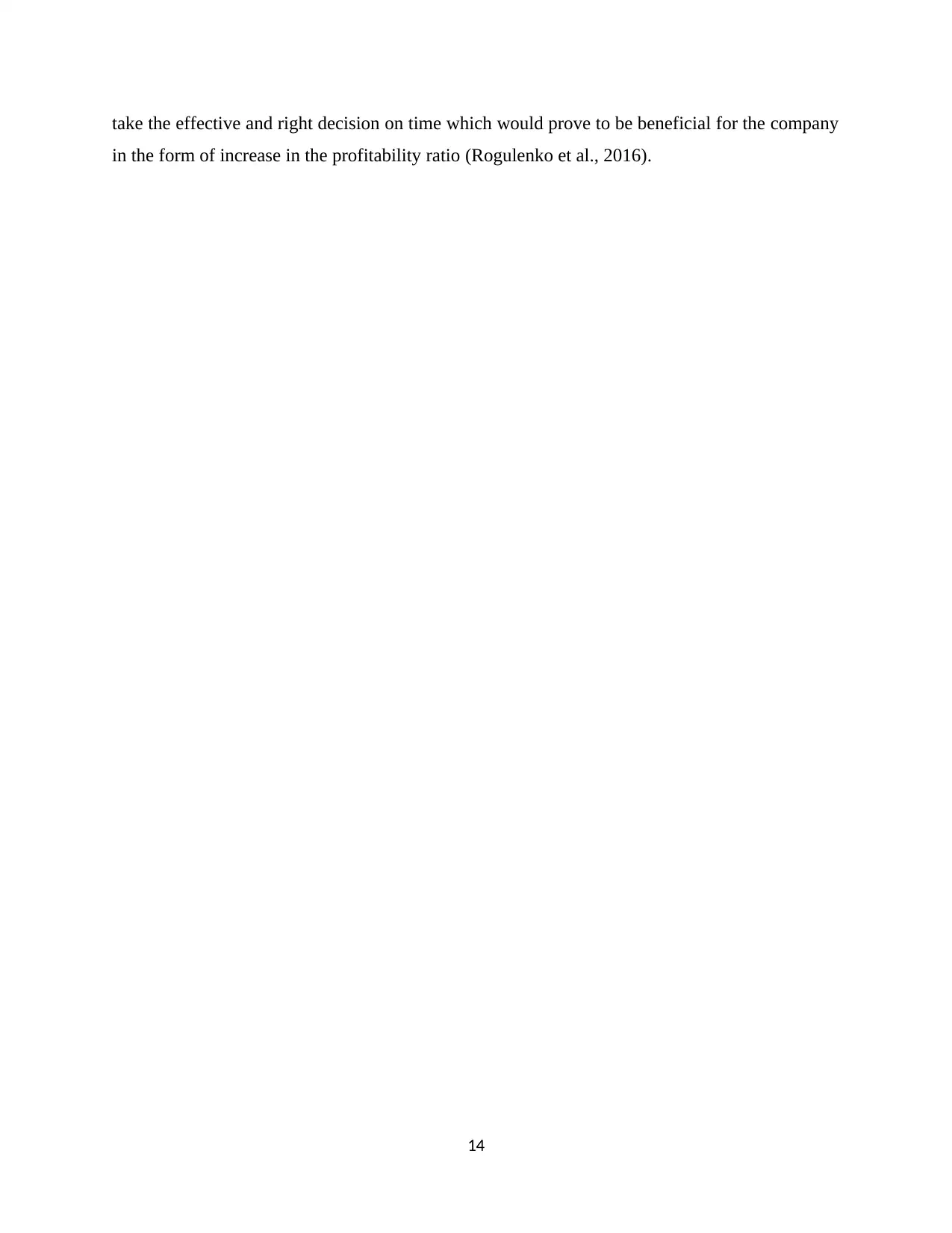
take the effective and right decision on time which would prove to be beneficial for the company
in the form of increase in the profitability ratio (Rogulenko et al., 2016).
14
in the form of increase in the profitability ratio (Rogulenko et al., 2016).
14
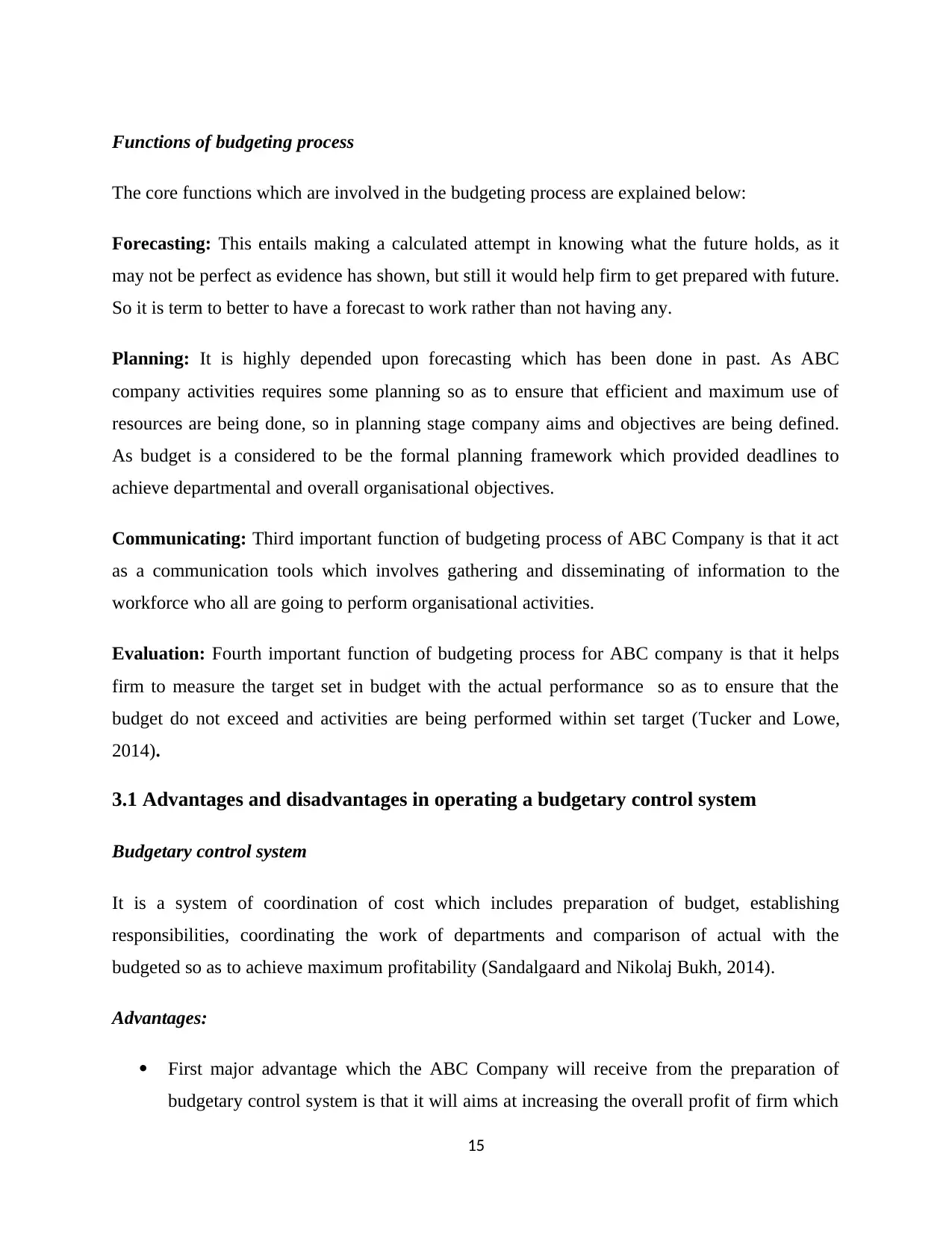
Functions of budgeting process
The core functions which are involved in the budgeting process are explained below:
Forecasting: This entails making a calculated attempt in knowing what the future holds, as it
may not be perfect as evidence has shown, but still it would help firm to get prepared with future.
So it is term to better to have a forecast to work rather than not having any.
Planning: It is highly depended upon forecasting which has been done in past. As ABC
company activities requires some planning so as to ensure that efficient and maximum use of
resources are being done, so in planning stage company aims and objectives are being defined.
As budget is a considered to be the formal planning framework which provided deadlines to
achieve departmental and overall organisational objectives.
Communicating: Third important function of budgeting process of ABC Company is that it act
as a communication tools which involves gathering and disseminating of information to the
workforce who all are going to perform organisational activities.
Evaluation: Fourth important function of budgeting process for ABC company is that it helps
firm to measure the target set in budget with the actual performance so as to ensure that the
budget do not exceed and activities are being performed within set target (Tucker and Lowe,
2014).
3.1 Advantages and disadvantages in operating a budgetary control system
Budgetary control system
It is a system of coordination of cost which includes preparation of budget, establishing
responsibilities, coordinating the work of departments and comparison of actual with the
budgeted so as to achieve maximum profitability (Sandalgaard and Nikolaj Bukh, 2014).
Advantages:
First major advantage which the ABC Company will receive from the preparation of
budgetary control system is that it will aims at increasing the overall profit of firm which
15
The core functions which are involved in the budgeting process are explained below:
Forecasting: This entails making a calculated attempt in knowing what the future holds, as it
may not be perfect as evidence has shown, but still it would help firm to get prepared with future.
So it is term to better to have a forecast to work rather than not having any.
Planning: It is highly depended upon forecasting which has been done in past. As ABC
company activities requires some planning so as to ensure that efficient and maximum use of
resources are being done, so in planning stage company aims and objectives are being defined.
As budget is a considered to be the formal planning framework which provided deadlines to
achieve departmental and overall organisational objectives.
Communicating: Third important function of budgeting process of ABC Company is that it act
as a communication tools which involves gathering and disseminating of information to the
workforce who all are going to perform organisational activities.
Evaluation: Fourth important function of budgeting process for ABC company is that it helps
firm to measure the target set in budget with the actual performance so as to ensure that the
budget do not exceed and activities are being performed within set target (Tucker and Lowe,
2014).
3.1 Advantages and disadvantages in operating a budgetary control system
Budgetary control system
It is a system of coordination of cost which includes preparation of budget, establishing
responsibilities, coordinating the work of departments and comparison of actual with the
budgeted so as to achieve maximum profitability (Sandalgaard and Nikolaj Bukh, 2014).
Advantages:
First major advantage which the ABC Company will receive from the preparation of
budgetary control system is that it will aims at increasing the overall profit of firm which
15
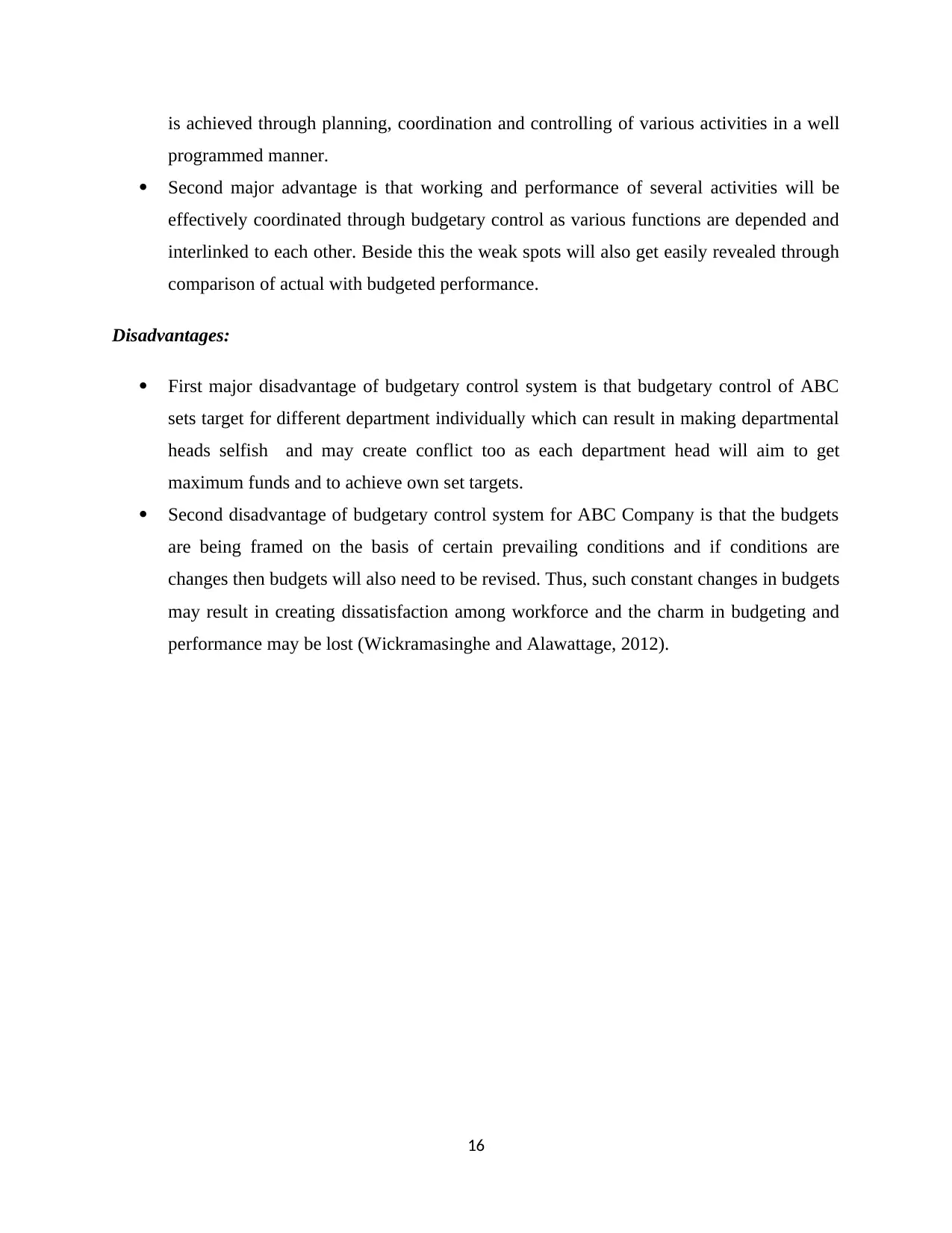
is achieved through planning, coordination and controlling of various activities in a well
programmed manner.
Second major advantage is that working and performance of several activities will be
effectively coordinated through budgetary control as various functions are depended and
interlinked to each other. Beside this the weak spots will also get easily revealed through
comparison of actual with budgeted performance.
Disadvantages:
First major disadvantage of budgetary control system is that budgetary control of ABC
sets target for different department individually which can result in making departmental
heads selfish and may create conflict too as each department head will aim to get
maximum funds and to achieve own set targets.
Second disadvantage of budgetary control system for ABC Company is that the budgets
are being framed on the basis of certain prevailing conditions and if conditions are
changes then budgets will also need to be revised. Thus, such constant changes in budgets
may result in creating dissatisfaction among workforce and the charm in budgeting and
performance may be lost (Wickramasinghe and Alawattage, 2012).
16
programmed manner.
Second major advantage is that working and performance of several activities will be
effectively coordinated through budgetary control as various functions are depended and
interlinked to each other. Beside this the weak spots will also get easily revealed through
comparison of actual with budgeted performance.
Disadvantages:
First major disadvantage of budgetary control system is that budgetary control of ABC
sets target for different department individually which can result in making departmental
heads selfish and may create conflict too as each department head will aim to get
maximum funds and to achieve own set targets.
Second disadvantage of budgetary control system for ABC Company is that the budgets
are being framed on the basis of certain prevailing conditions and if conditions are
changes then budgets will also need to be revised. Thus, such constant changes in budgets
may result in creating dissatisfaction among workforce and the charm in budgeting and
performance may be lost (Wickramasinghe and Alawattage, 2012).
16
Secure Best Marks with AI Grader
Need help grading? Try our AI Grader for instant feedback on your assignments.
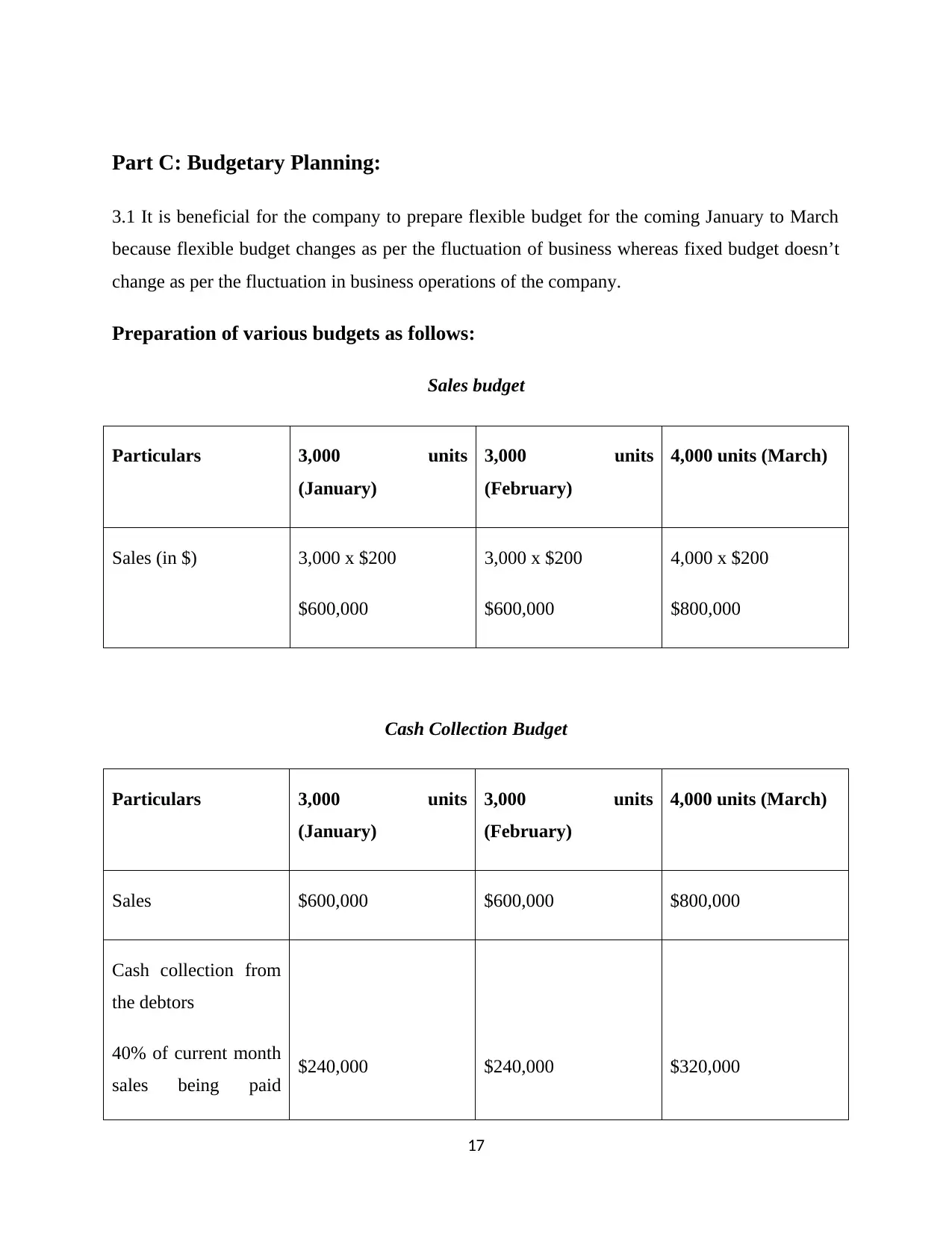
Part C: Budgetary Planning:
3.1 It is beneficial for the company to prepare flexible budget for the coming January to March
because flexible budget changes as per the fluctuation of business whereas fixed budget doesn’t
change as per the fluctuation in business operations of the company.
Preparation of various budgets as follows:
Sales budget
Particulars 3,000 units
(January)
3,000 units
(February)
4,000 units (March)
Sales (in $) 3,000 x $200
$600,000
3,000 x $200
$600,000
4,000 x $200
$800,000
Cash Collection Budget
Particulars 3,000 units
(January)
3,000 units
(February)
4,000 units (March)
Sales $600,000 $600,000 $800,000
Cash collection from
the debtors
40% of current month
sales being paid
$240,000 $240,000 $320,000
17
3.1 It is beneficial for the company to prepare flexible budget for the coming January to March
because flexible budget changes as per the fluctuation of business whereas fixed budget doesn’t
change as per the fluctuation in business operations of the company.
Preparation of various budgets as follows:
Sales budget
Particulars 3,000 units
(January)
3,000 units
(February)
4,000 units (March)
Sales (in $) 3,000 x $200
$600,000
3,000 x $200
$600,000
4,000 x $200
$800,000
Cash Collection Budget
Particulars 3,000 units
(January)
3,000 units
(February)
4,000 units (March)
Sales $600,000 $600,000 $800,000
Cash collection from
the debtors
40% of current month
sales being paid
$240,000 $240,000 $320,000
17
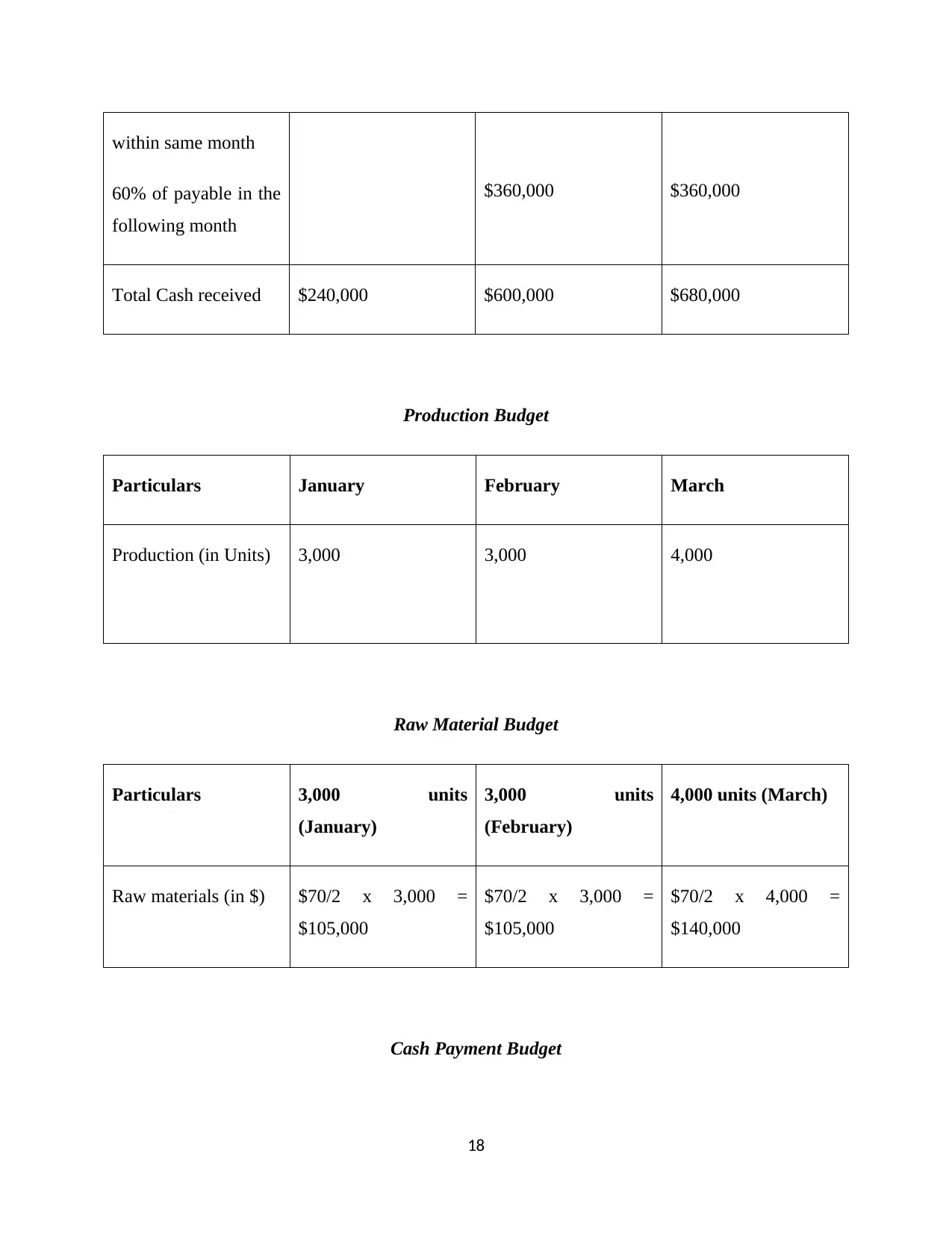
within same month
60% of payable in the
following month
$360,000 $360,000
Total Cash received $240,000 $600,000 $680,000
Production Budget
Particulars January February March
Production (in Units) 3,000 3,000 4,000
Raw Material Budget
Particulars 3,000 units
(January)
3,000 units
(February)
4,000 units (March)
Raw materials (in $) $70/2 x 3,000 =
$105,000
$70/2 x 3,000 =
$105,000
$70/2 x 4,000 =
$140,000
Cash Payment Budget
18
60% of payable in the
following month
$360,000 $360,000
Total Cash received $240,000 $600,000 $680,000
Production Budget
Particulars January February March
Production (in Units) 3,000 3,000 4,000
Raw Material Budget
Particulars 3,000 units
(January)
3,000 units
(February)
4,000 units (March)
Raw materials (in $) $70/2 x 3,000 =
$105,000
$70/2 x 3,000 =
$105,000
$70/2 x 4,000 =
$140,000
Cash Payment Budget
18
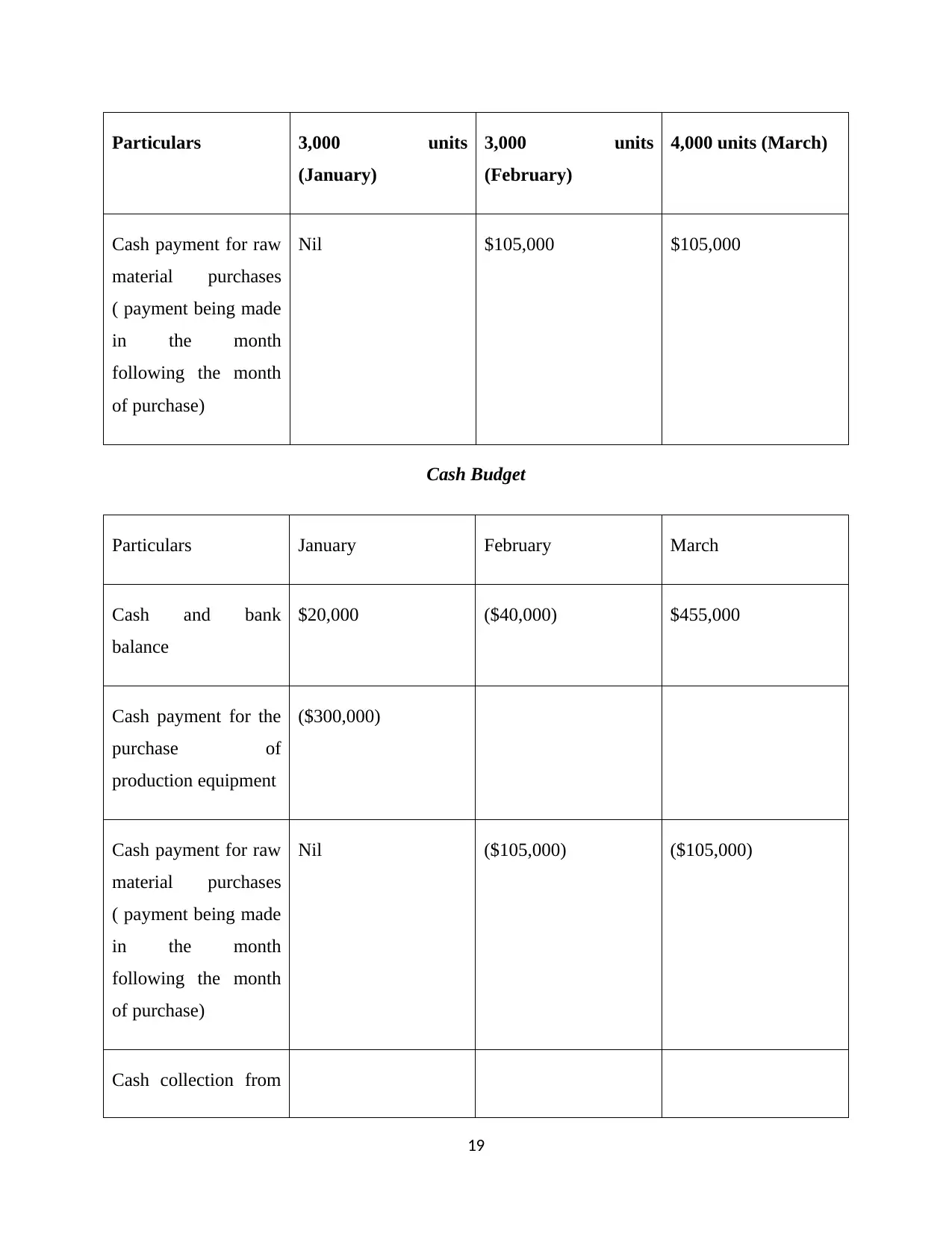
Particulars 3,000 units
(January)
3,000 units
(February)
4,000 units (March)
Cash payment for raw
material purchases
( payment being made
in the month
following the month
of purchase)
Nil $105,000 $105,000
Cash Budget
Particulars January February March
Cash and bank
balance
$20,000 ($40,000) $455,000
Cash payment for the
purchase of
production equipment
($300,000)
Cash payment for raw
material purchases
( payment being made
in the month
following the month
of purchase)
Nil ($105,000) ($105,000)
Cash collection from
19
(January)
3,000 units
(February)
4,000 units (March)
Cash payment for raw
material purchases
( payment being made
in the month
following the month
of purchase)
Nil $105,000 $105,000
Cash Budget
Particulars January February March
Cash and bank
balance
$20,000 ($40,000) $455,000
Cash payment for the
purchase of
production equipment
($300,000)
Cash payment for raw
material purchases
( payment being made
in the month
following the month
of purchase)
Nil ($105,000) ($105,000)
Cash collection from
19
Paraphrase This Document
Need a fresh take? Get an instant paraphrase of this document with our AI Paraphraser
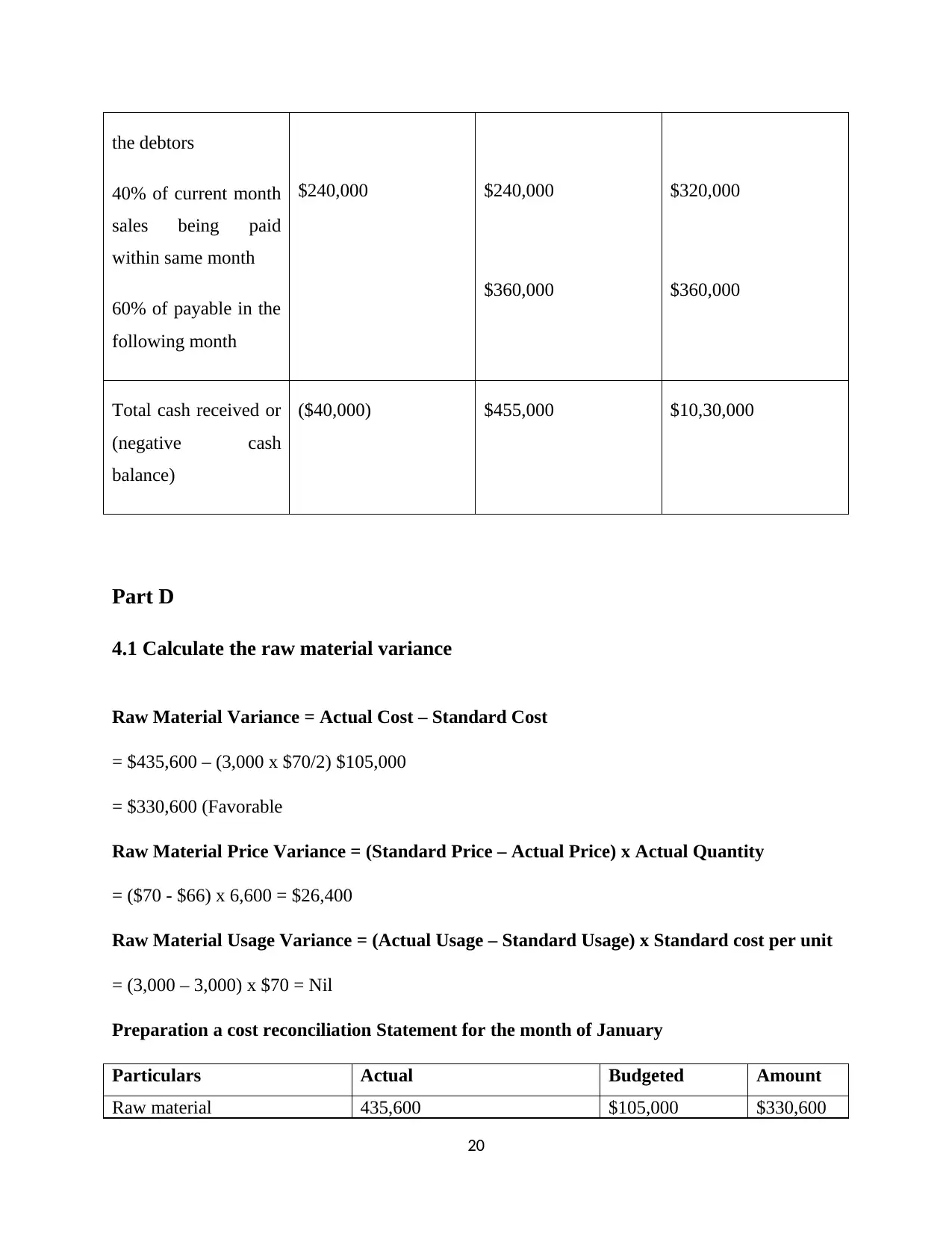
the debtors
40% of current month
sales being paid
within same month
60% of payable in the
following month
$240,000 $240,000
$360,000
$320,000
$360,000
Total cash received or
(negative cash
balance)
($40,000) $455,000 $10,30,000
Part D
4.1 Calculate the raw material variance
Raw Material Variance = Actual Cost – Standard Cost
= $435,600 – (3,000 x $70/2) $105,000
= $330,600 (Favorable
Raw Material Price Variance = (Standard Price – Actual Price) x Actual Quantity
= ($70 - $66) x 6,600 = $26,400
Raw Material Usage Variance = (Actual Usage – Standard Usage) x Standard cost per unit
= (3,000 – 3,000) x $70 = Nil
Preparation a cost reconciliation Statement for the month of January
Particulars Actual Budgeted Amount
Raw material 435,600 $105,000 $330,600
20
40% of current month
sales being paid
within same month
60% of payable in the
following month
$240,000 $240,000
$360,000
$320,000
$360,000
Total cash received or
(negative cash
balance)
($40,000) $455,000 $10,30,000
Part D
4.1 Calculate the raw material variance
Raw Material Variance = Actual Cost – Standard Cost
= $435,600 – (3,000 x $70/2) $105,000
= $330,600 (Favorable
Raw Material Price Variance = (Standard Price – Actual Price) x Actual Quantity
= ($70 - $66) x 6,600 = $26,400
Raw Material Usage Variance = (Actual Usage – Standard Usage) x Standard cost per unit
= (3,000 – 3,000) x $70 = Nil
Preparation a cost reconciliation Statement for the month of January
Particulars Actual Budgeted Amount
Raw material 435,600 $105,000 $330,600
20
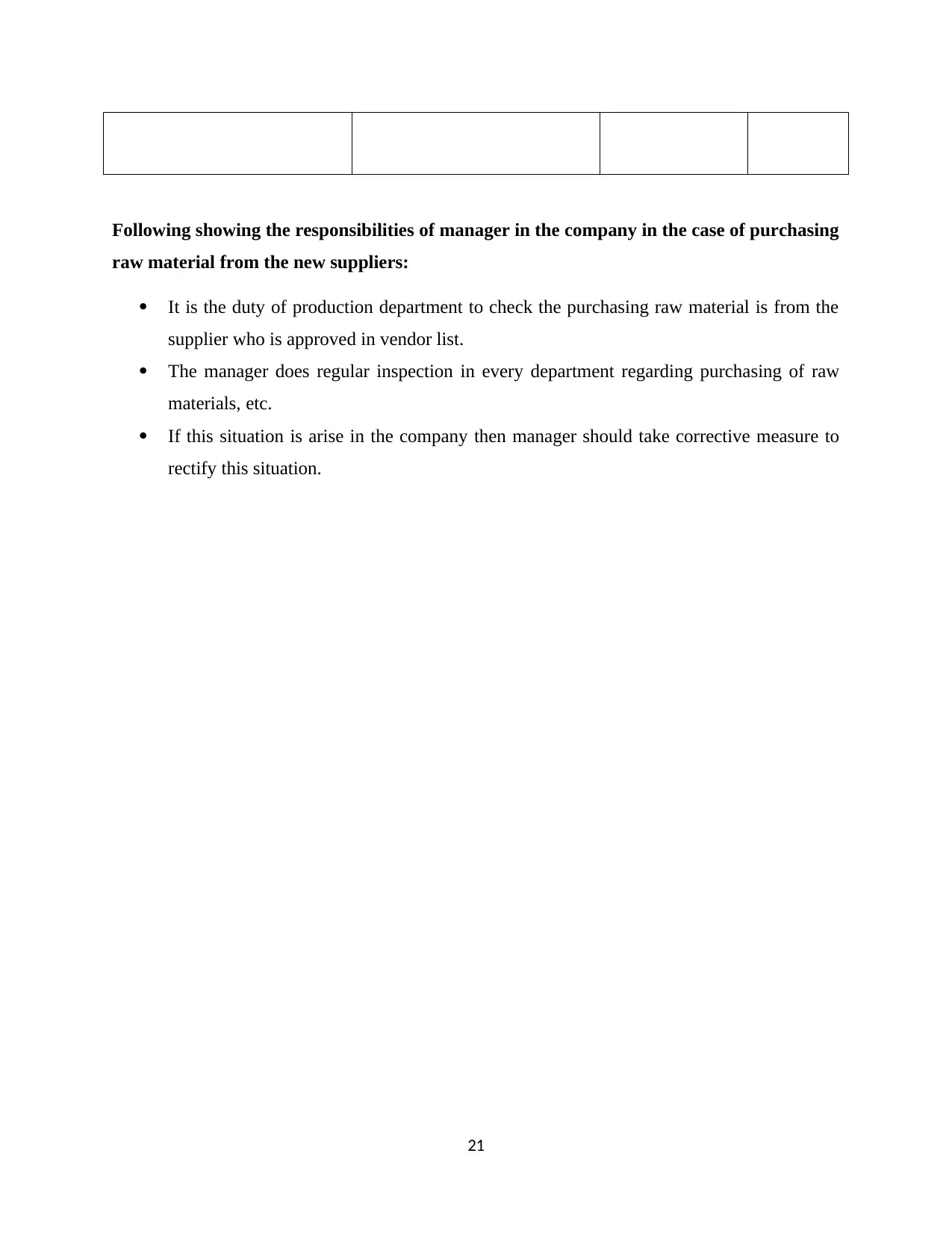
Following showing the responsibilities of manager in the company in the case of purchasing
raw material from the new suppliers:
It is the duty of production department to check the purchasing raw material is from the
supplier who is approved in vendor list.
The manager does regular inspection in every department regarding purchasing of raw
materials, etc.
If this situation is arise in the company then manager should take corrective measure to
rectify this situation.
21
raw material from the new suppliers:
It is the duty of production department to check the purchasing raw material is from the
supplier who is approved in vendor list.
The manager does regular inspection in every department regarding purchasing of raw
materials, etc.
If this situation is arise in the company then manager should take corrective measure to
rectify this situation.
21
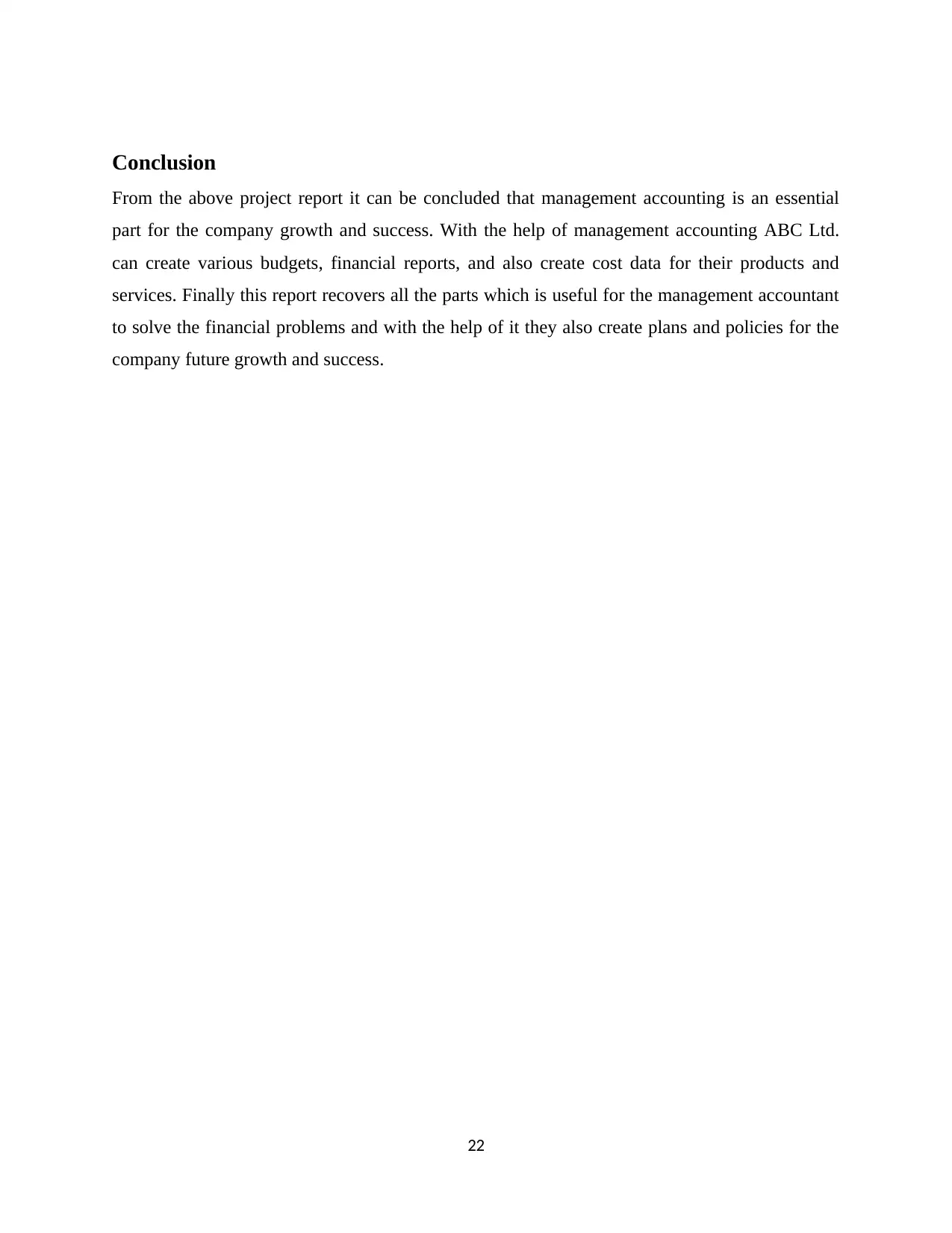
Conclusion
From the above project report it can be concluded that management accounting is an essential
part for the company growth and success. With the help of management accounting ABC Ltd.
can create various budgets, financial reports, and also create cost data for their products and
services. Finally this report recovers all the parts which is useful for the management accountant
to solve the financial problems and with the help of it they also create plans and policies for the
company future growth and success.
22
From the above project report it can be concluded that management accounting is an essential
part for the company growth and success. With the help of management accounting ABC Ltd.
can create various budgets, financial reports, and also create cost data for their products and
services. Finally this report recovers all the parts which is useful for the management accountant
to solve the financial problems and with the help of it they also create plans and policies for the
company future growth and success.
22
Secure Best Marks with AI Grader
Need help grading? Try our AI Grader for instant feedback on your assignments.
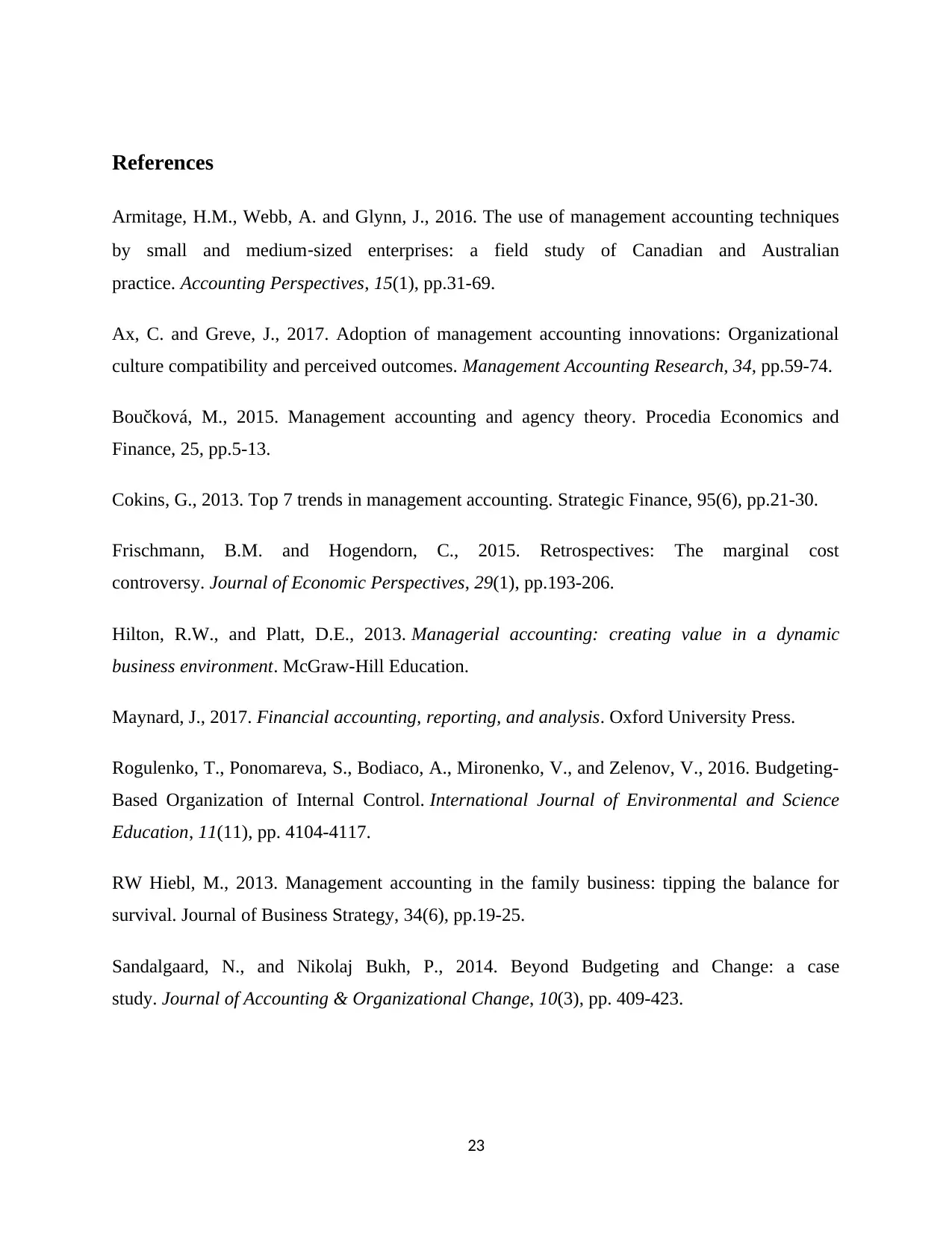
References
Armitage, H.M., Webb, A. and Glynn, J., 2016. The use of management accounting techniques
by small and medium‐sized enterprises: a field study of Canadian and Australian
practice. Accounting Perspectives, 15(1), pp.31-69.
Ax, C. and Greve, J., 2017. Adoption of management accounting innovations: Organizational
culture compatibility and perceived outcomes. Management Accounting Research, 34, pp.59-74.
Boučková, M., 2015. Management accounting and agency theory. Procedia Economics and
Finance, 25, pp.5-13.
Cokins, G., 2013. Top 7 trends in management accounting. Strategic Finance, 95(6), pp.21-30.
Frischmann, B.M. and Hogendorn, C., 2015. Retrospectives: The marginal cost
controversy. Journal of Economic Perspectives, 29(1), pp.193-206.
Hilton, R.W., and Platt, D.E., 2013. Managerial accounting: creating value in a dynamic
business environment. McGraw-Hill Education.
Maynard, J., 2017. Financial accounting, reporting, and analysis. Oxford University Press.
Rogulenko, T., Ponomareva, S., Bodiaco, A., Mironenko, V., and Zelenov, V., 2016. Budgeting-
Based Organization of Internal Control. International Journal of Environmental and Science
Education, 11(11), pp. 4104-4117.
RW Hiebl, M., 2013. Management accounting in the family business: tipping the balance for
survival. Journal of Business Strategy, 34(6), pp.19-25.
Sandalgaard, N., and Nikolaj Bukh, P., 2014. Beyond Budgeting and Change: a case
study. Journal of Accounting & Organizational Change, 10(3), pp. 409-423.
23
Armitage, H.M., Webb, A. and Glynn, J., 2016. The use of management accounting techniques
by small and medium‐sized enterprises: a field study of Canadian and Australian
practice. Accounting Perspectives, 15(1), pp.31-69.
Ax, C. and Greve, J., 2017. Adoption of management accounting innovations: Organizational
culture compatibility and perceived outcomes. Management Accounting Research, 34, pp.59-74.
Boučková, M., 2015. Management accounting and agency theory. Procedia Economics and
Finance, 25, pp.5-13.
Cokins, G., 2013. Top 7 trends in management accounting. Strategic Finance, 95(6), pp.21-30.
Frischmann, B.M. and Hogendorn, C., 2015. Retrospectives: The marginal cost
controversy. Journal of Economic Perspectives, 29(1), pp.193-206.
Hilton, R.W., and Platt, D.E., 2013. Managerial accounting: creating value in a dynamic
business environment. McGraw-Hill Education.
Maynard, J., 2017. Financial accounting, reporting, and analysis. Oxford University Press.
Rogulenko, T., Ponomareva, S., Bodiaco, A., Mironenko, V., and Zelenov, V., 2016. Budgeting-
Based Organization of Internal Control. International Journal of Environmental and Science
Education, 11(11), pp. 4104-4117.
RW Hiebl, M., 2013. Management accounting in the family business: tipping the balance for
survival. Journal of Business Strategy, 34(6), pp.19-25.
Sandalgaard, N., and Nikolaj Bukh, P., 2014. Beyond Budgeting and Change: a case
study. Journal of Accounting & Organizational Change, 10(3), pp. 409-423.
23
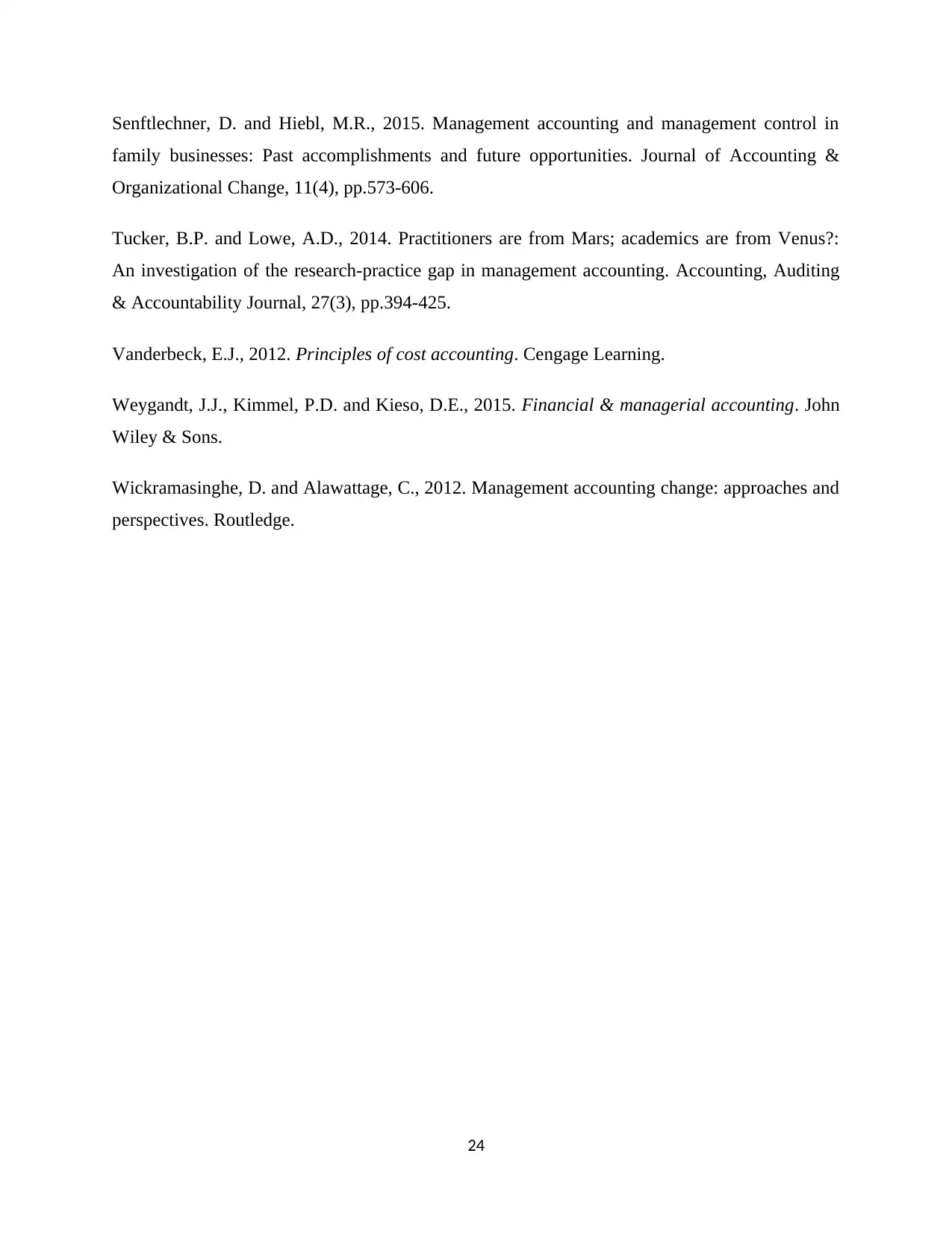
Senftlechner, D. and Hiebl, M.R., 2015. Management accounting and management control in
family businesses: Past accomplishments and future opportunities. Journal of Accounting &
Organizational Change, 11(4), pp.573-606.
Tucker, B.P. and Lowe, A.D., 2014. Practitioners are from Mars; academics are from Venus?:
An investigation of the research-practice gap in management accounting. Accounting, Auditing
& Accountability Journal, 27(3), pp.394-425.
Vanderbeck, E.J., 2012. Principles of cost accounting. Cengage Learning.
Weygandt, J.J., Kimmel, P.D. and Kieso, D.E., 2015. Financial & managerial accounting. John
Wiley & Sons.
Wickramasinghe, D. and Alawattage, C., 2012. Management accounting change: approaches and
perspectives. Routledge.
24
family businesses: Past accomplishments and future opportunities. Journal of Accounting &
Organizational Change, 11(4), pp.573-606.
Tucker, B.P. and Lowe, A.D., 2014. Practitioners are from Mars; academics are from Venus?:
An investigation of the research-practice gap in management accounting. Accounting, Auditing
& Accountability Journal, 27(3), pp.394-425.
Vanderbeck, E.J., 2012. Principles of cost accounting. Cengage Learning.
Weygandt, J.J., Kimmel, P.D. and Kieso, D.E., 2015. Financial & managerial accounting. John
Wiley & Sons.
Wickramasinghe, D. and Alawattage, C., 2012. Management accounting change: approaches and
perspectives. Routledge.
24
1 out of 24
Related Documents
Your All-in-One AI-Powered Toolkit for Academic Success.
+13062052269
info@desklib.com
Available 24*7 on WhatsApp / Email
![[object Object]](/_next/static/media/star-bottom.7253800d.svg)
Unlock your academic potential
© 2024 | Zucol Services PVT LTD | All rights reserved.





